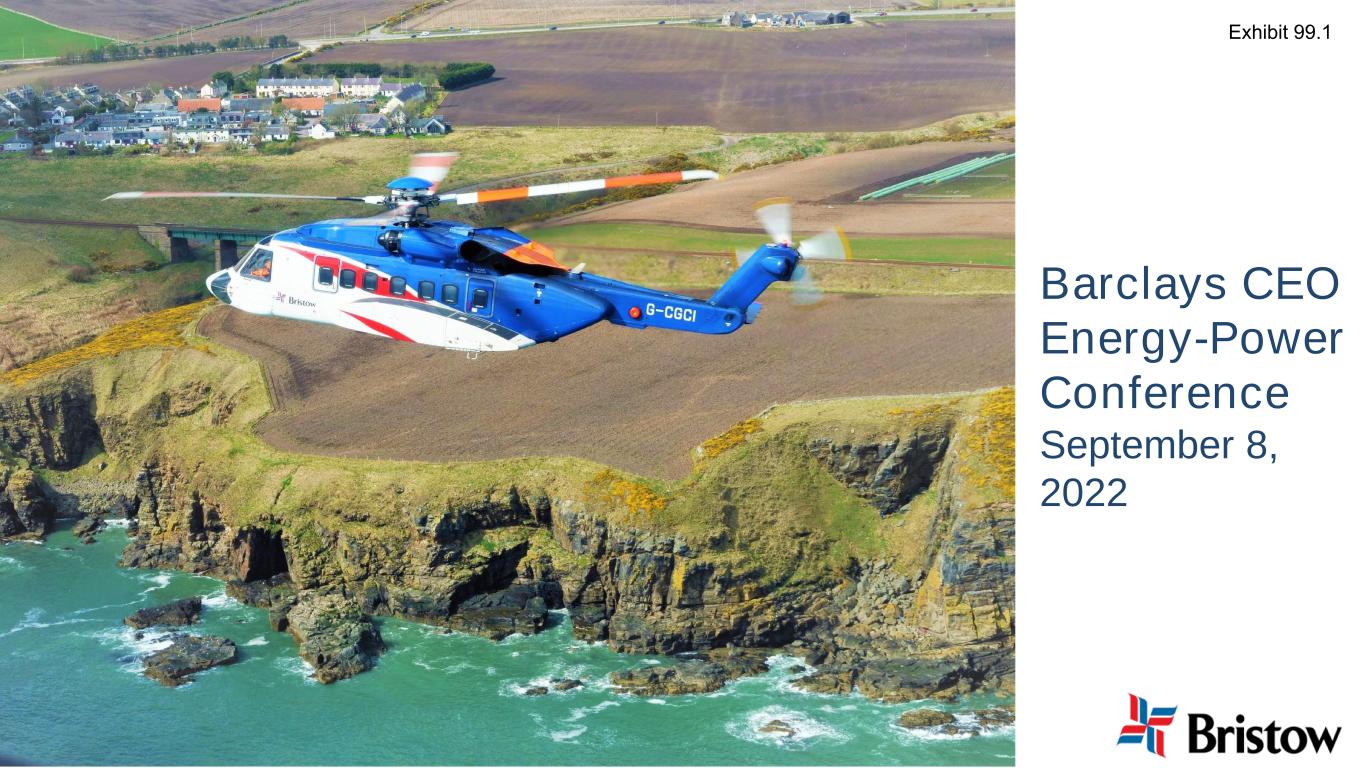
Barclays CEO Energy-Power Conference September 8, 2022 Exhibit 99.1
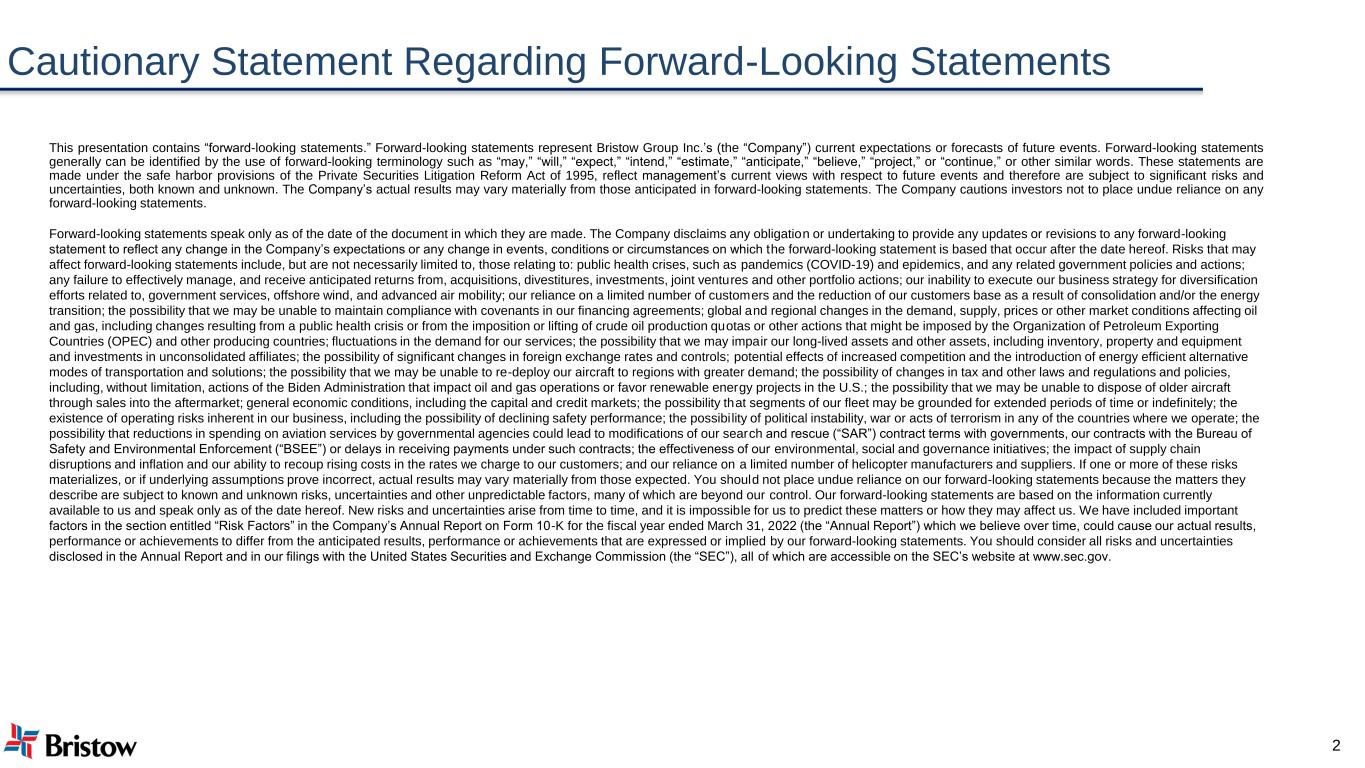
This presentation contains “forward-looking statements.” Forward-looking statements represent Bristow Group Inc.’s (the “Company”) current expectations or forecasts of future events. Forward-looking statements generally can be identified by the use of forward-looking terminology such as “may,” “will,” “expect,” “intend,” “estimate,” “anticipate,” “believe,” “project,” or “continue,” or other similar words. These statements are made under the safe harbor provisions of the Private Securities Litigation Reform Act of 1995, reflect management’s current views with respect to future events and therefore are subject to significant risks and uncertainties, both known and unknown. The Company’s actual results may vary materially from those anticipated in forward-looking statements. The Company cautions investors not to place undue reliance on any forward-looking statements. Forward-looking statements speak only as of the date of the document in which they are made. The Company disclaims any obligation or undertaking to provide any updates or revisions to any forward-looking statement to reflect any change in the Company’s expectations or any change in events, conditions or circumstances on which the forward-looking statement is based that occur after the date hereof. Risks that may affect forward-looking statements include, but are not necessarily limited to, those relating to: public health crises, such as pandemics (COVID-19) and epidemics, and any related government policies and actions; any failure to effectively manage, and receive anticipated returns from, acquisitions, divestitures, investments, joint ventures and other portfolio actions; our inability to execute our business strategy for diversification efforts related to, government services, offshore wind, and advanced air mobility; our reliance on a limited number of customers and the reduction of our customers base as a result of consolidation and/or the energy transition; the possibility that we may be unable to maintain compliance with covenants in our financing agreements; global and regional changes in the demand, supply, prices or other market conditions affecting oil and gas, including changes resulting from a public health crisis or from the imposition or lifting of crude oil production quotas or other actions that might be imposed by the Organization of Petroleum Exporting Countries (OPEC) and other producing countries; fluctuations in the demand for our services; the possibility that we may impair our long-lived assets and other assets, including inventory, property and equipment and investments in unconsolidated affiliates; the possibility of significant changes in foreign exchange rates and controls; potential effects of increased competition and the introduction of energy efficient alternative modes of transportation and solutions; the possibility that we may be unable to re-deploy our aircraft to regions with greater demand; the possibility of changes in tax and other laws and regulations and policies, including, without limitation, actions of the Biden Administration that impact oil and gas operations or favor renewable energy projects in the U.S.; the possibility that we may be unable to dispose of older aircraft through sales into the aftermarket; general economic conditions, including the capital and credit markets; the possibility that segments of our fleet may be grounded for extended periods of time or indefinitely; the existence of operating risks inherent in our business, including the possibility of declining safety performance; the possibi lity of political instability, war or acts of terrorism in any of the countries where we operate; the possibility that reductions in spending on aviation services by governmental agencies could lead to modifications of our search and rescue (“SAR”) contract terms with governments, our contracts with the Bureau of Safety and Environmental Enforcement (“BSEE”) or delays in receiving payments under such contracts; the effectiveness of our environmental, social and governance initiatives; the impact of supply chain disruptions and inflation and our ability to recoup rising costs in the rates we charge to our customers; and our reliance on a limited number of helicopter manufacturers and suppliers. If one or more of these risks materializes, or if underlying assumptions prove incorrect, actual results may vary materially from those expected. You should not place undue reliance on our forward-looking statements because the matters they describe are subject to known and unknown risks, uncertainties and other unpredictable factors, many of which are beyond our control. Our forward-looking statements are based on the information currently available to us and speak only as of the date hereof. New risks and uncertainties arise from time to time, and it is impossible for us to predict these matters or how they may affect us. We have included important factors in the section entitled “Risk Factors” in the Company’s Annual Report on Form 10-K for the fiscal year ended March 31, 2022 (the “Annual Report”) which we believe over time, could cause our actual results, performance or achievements to differ from the anticipated results, performance or achievements that are expressed or implied by our forward-looking statements. You should consider all risks and uncertainties disclosed in the Annual Report and in our filings with the United States Securities and Exchange Commission (the “SEC”), all of which are accessible on the SEC’s website at www.sec.gov. Cautionary Statement Regarding Forward-Looking Statements 2
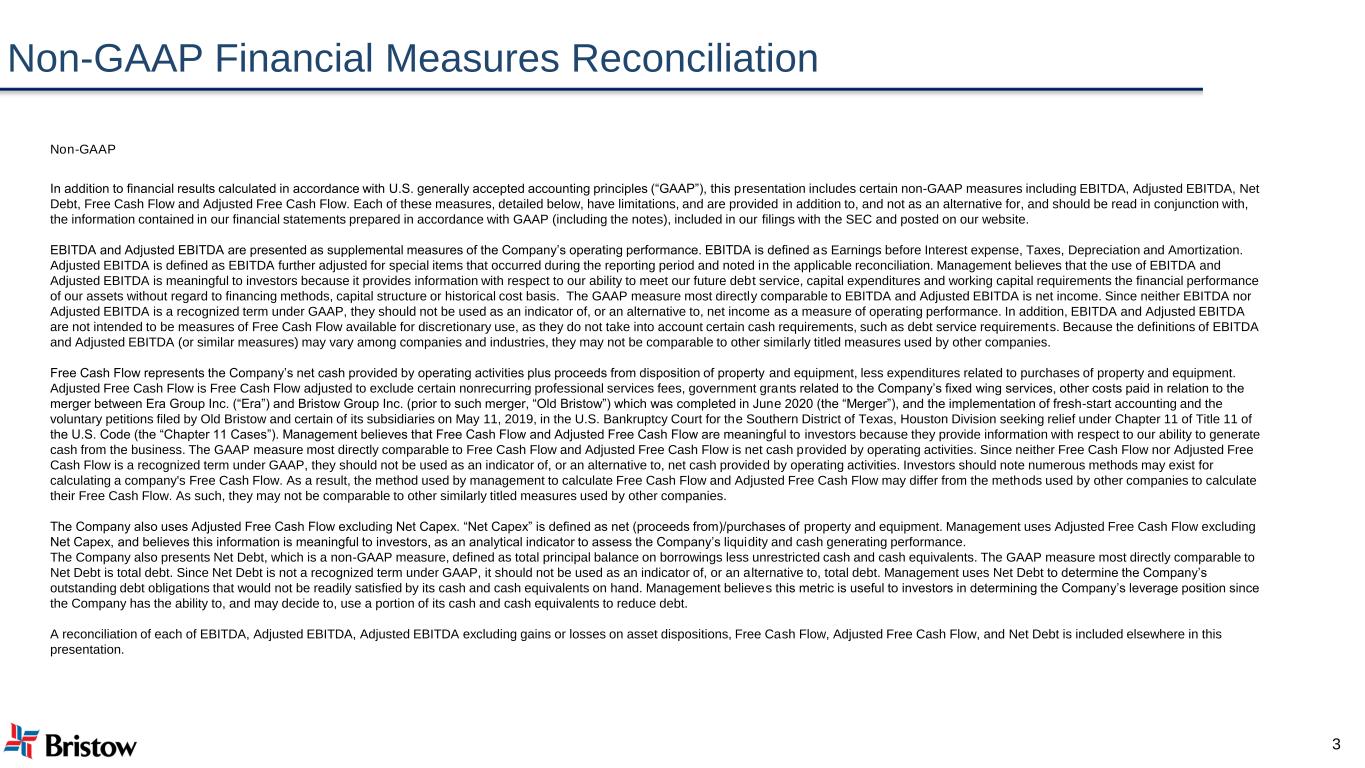
Non-GAAP In addition to financial results calculated in accordance with U.S. generally accepted accounting principles (“GAAP”), this presentation includes certain non-GAAP measures including EBITDA, Adjusted EBITDA, Net Debt, Free Cash Flow and Adjusted Free Cash Flow. Each of these measures, detailed below, have limitations, and are provided in addition to, and not as an alternative for, and should be read in conjunction with, the information contained in our financial statements prepared in accordance with GAAP (including the notes), included in our filings with the SEC and posted on our website. EBITDA and Adjusted EBITDA are presented as supplemental measures of the Company’s operating performance. EBITDA is defined as Earnings before Interest expense, Taxes, Depreciation and Amortization. Adjusted EBITDA is defined as EBITDA further adjusted for special items that occurred during the reporting period and noted in the applicable reconciliation. Management believes that the use of EBITDA and Adjusted EBITDA is meaningful to investors because it provides information with respect to our ability to meet our future debt service, capital expenditures and working capital requirements the financial performance of our assets without regard to financing methods, capital structure or historical cost basis. The GAAP measure most directly comparable to EBITDA and Adjusted EBITDA is net income. Since neither EBITDA nor Adjusted EBITDA is a recognized term under GAAP, they should not be used as an indicator of, or an alternative to, net income as a measure of operating performance. In addition, EBITDA and Adjusted EBITDA are not intended to be measures of Free Cash Flow available for discretionary use, as they do not take into account certain cash requirements, such as debt service requirements. Because the definitions of EBITDA and Adjusted EBITDA (or similar measures) may vary among companies and industries, they may not be comparable to other similarly titled measures used by other companies. Free Cash Flow represents the Company’s net cash provided by operating activities plus proceeds from disposition of property and equipment, less expenditures related to purchases of property and equipment. Adjusted Free Cash Flow is Free Cash Flow adjusted to exclude certain nonrecurring professional services fees, government grants related to the Company’s fixed wing services, other costs paid in relation to the merger between Era Group Inc. (“Era”) and Bristow Group Inc. (prior to such merger, “Old Bristow”) which was completed in June 2020 (the “Merger”), and the implementation of fresh-start accounting and the voluntary petitions filed by Old Bristow and certain of its subsidiaries on May 11, 2019, in the U.S. Bankruptcy Court for the Southern District of Texas, Houston Division seeking relief under Chapter 11 of Title 11 of the U.S. Code (the “Chapter 11 Cases”). Management believes that Free Cash Flow and Adjusted Free Cash Flow are meaningful to investors because they provide information with respect to our ability to generate cash from the business. The GAAP measure most directly comparable to Free Cash Flow and Adjusted Free Cash Flow is net cash provided by operating activities. Since neither Free Cash Flow nor Adjusted Free Cash Flow is a recognized term under GAAP, they should not be used as an indicator of, or an alternative to, net cash provided by operating activities. Investors should note numerous methods may exist for calculating a company's Free Cash Flow. As a result, the method used by management to calculate Free Cash Flow and Adjusted Free Cash Flow may differ from the methods used by other companies to calculate their Free Cash Flow. As such, they may not be comparable to other similarly titled measures used by other companies. The Company also uses Adjusted Free Cash Flow excluding Net Capex. “Net Capex” is defined as net (proceeds from)/purchases of property and equipment. Management uses Adjusted Free Cash Flow excluding Net Capex, and believes this information is meaningful to investors, as an analytical indicator to assess the Company’s liquidity and cash generating performance. The Company also presents Net Debt, which is a non-GAAP measure, defined as total principal balance on borrowings less unrestricted cash and cash equivalents. The GAAP measure most directly comparable to Net Debt is total debt. Since Net Debt is not a recognized term under GAAP, it should not be used as an indicator of, or an alternative to, total debt. Management uses Net Debt to determine the Company’s outstanding debt obligations that would not be readily satisfied by its cash and cash equivalents on hand. Management believes this metric is useful to investors in determining the Company’s leverage position since the Company has the ability to, and may decide to, use a portion of its cash and cash equivalents to reduce debt. A reconciliation of each of EBITDA, Adjusted EBITDA, Adjusted EBITDA excluding gains or losses on asset dispositions, Free Cash Flow, Adjusted Free Cash Flow, and Net Debt is included elsewhere in this presentation. Non-GAAP Financial Measures Reconciliation 3
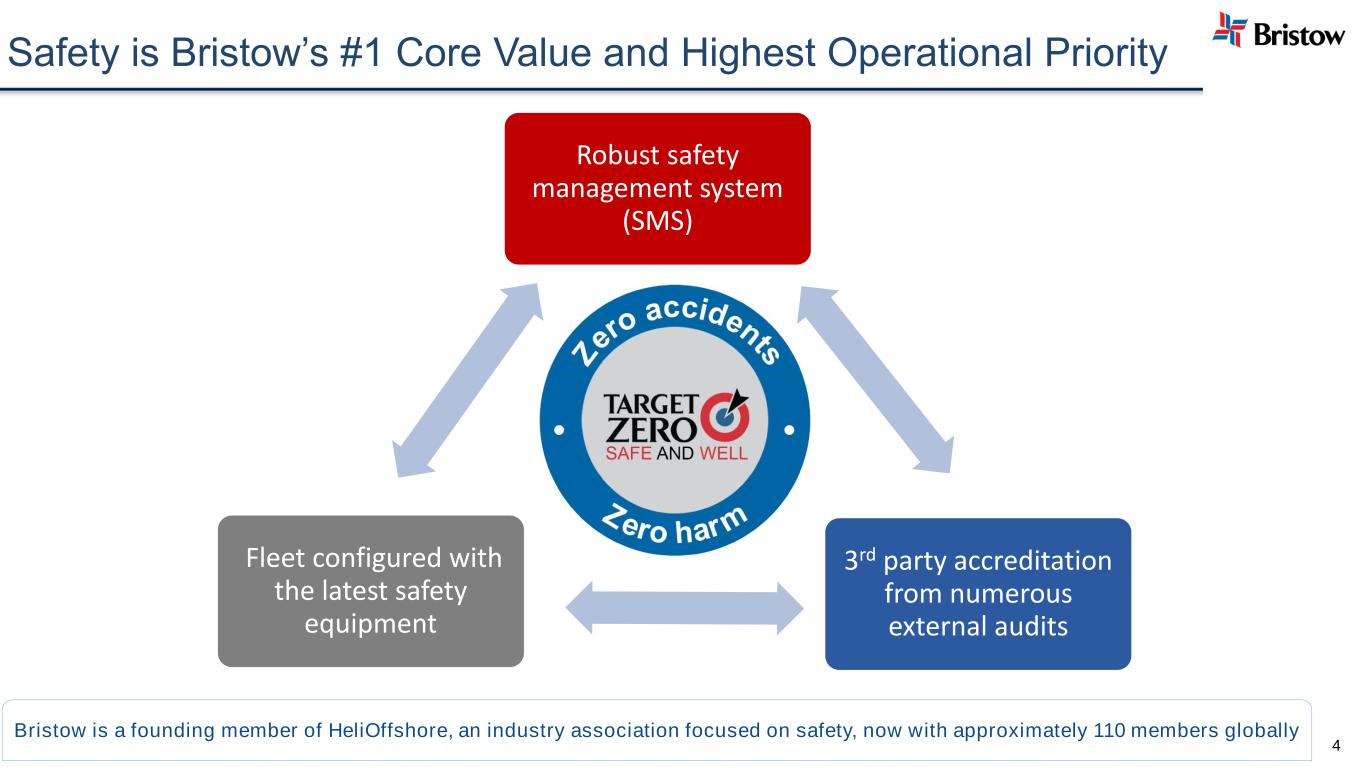
Safety is Bristow’s #1 Core Value and Highest Operational Priority 4 3rd party accreditation from numerous external audits Fleet configured with the latest safety equipment Robust safety management system (SMS) Bristow is a founding member of HeliOffshore, an industry association focused on safety, now with approximately 110 members globally
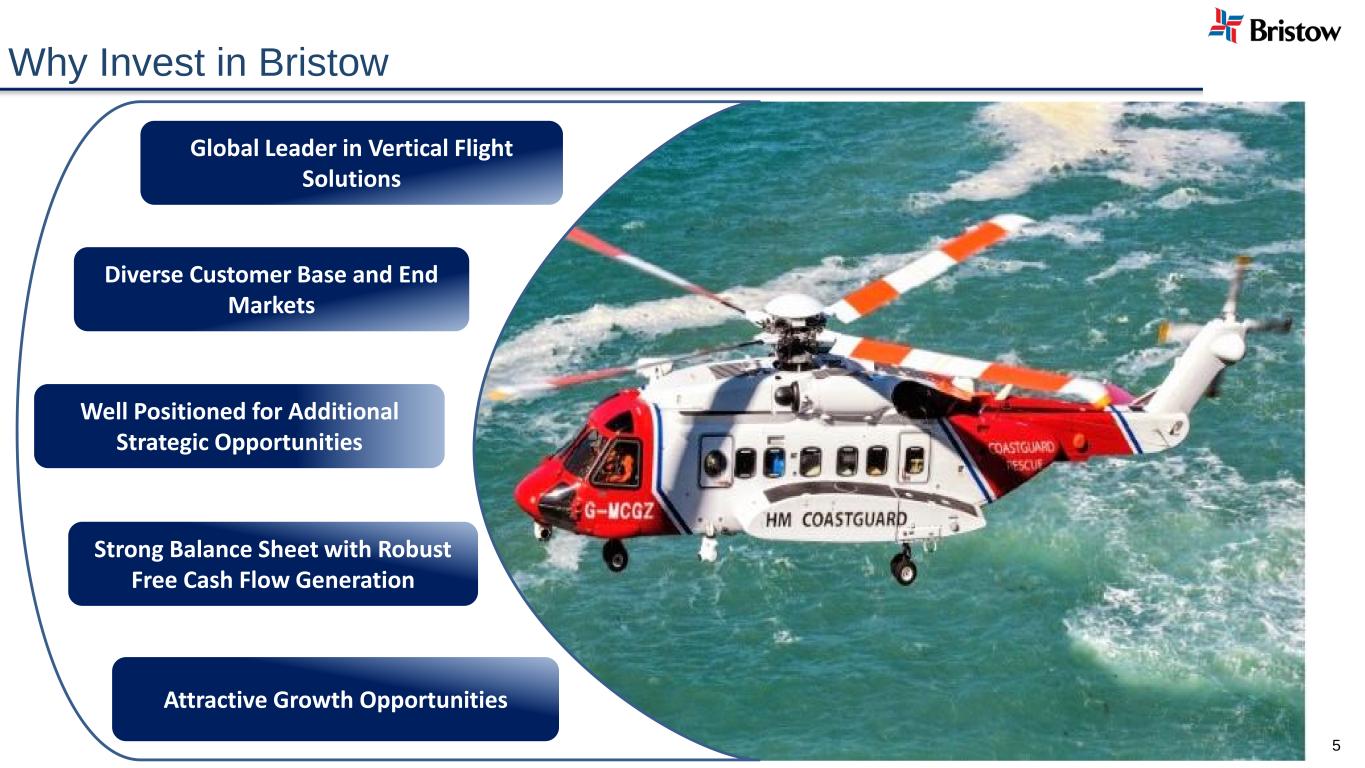
5 Why Invest in Bristow Global Leader in Vertical Flight Solutions Diverse Customer Base and End Markets Well Positioned for Additional Strategic Opportunities Strong Balance Sheet with Robust Free Cash Flow Generation Attractive Growth Opportunities
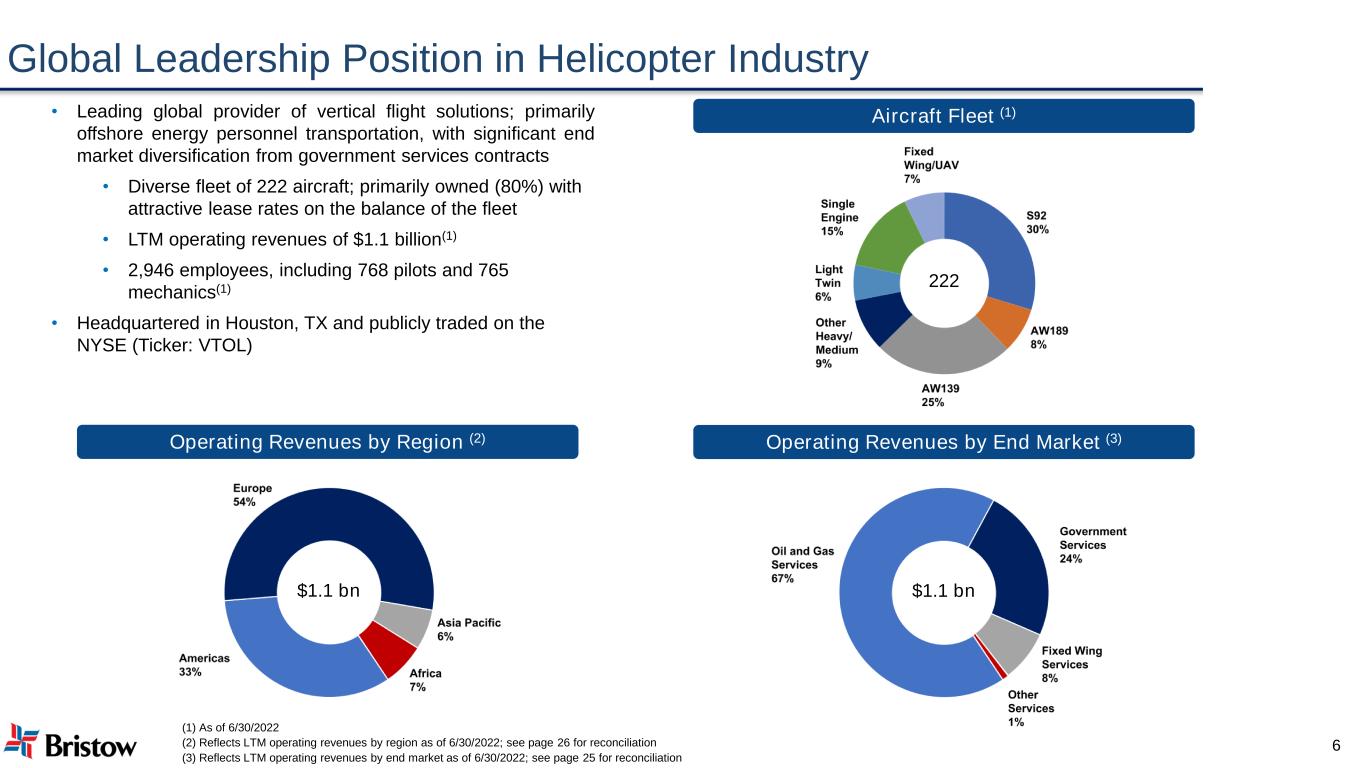
Global Leadership Position in Helicopter Industry Aircraft Fleet (1)• Leading global provider of vertical flight solutions; primarily offshore energy personnel transportation, with significant end market diversification from government services contracts • Diverse fleet of 222 aircraft; primarily owned (80%) with attractive lease rates on the balance of the fleet • LTM operating revenues of $1.1 billion(1) • 2,946 employees, including 768 pilots and 765 mechanics(1) • Headquartered in Houston, TX and publicly traded on the NYSE (Ticker: VTOL) Operating Revenues by End Market (3) (1) As of 6/30/2022 (2) Reflects LTM operating revenues by region as of 6/30/2022; see page 26 for reconciliation (3) Reflects LTM operating revenues by end market as of 6/30/2022; see page 25 for reconciliation 222 $1.1 bn 6 Operating Revenues by Region (2) $1.1 bn
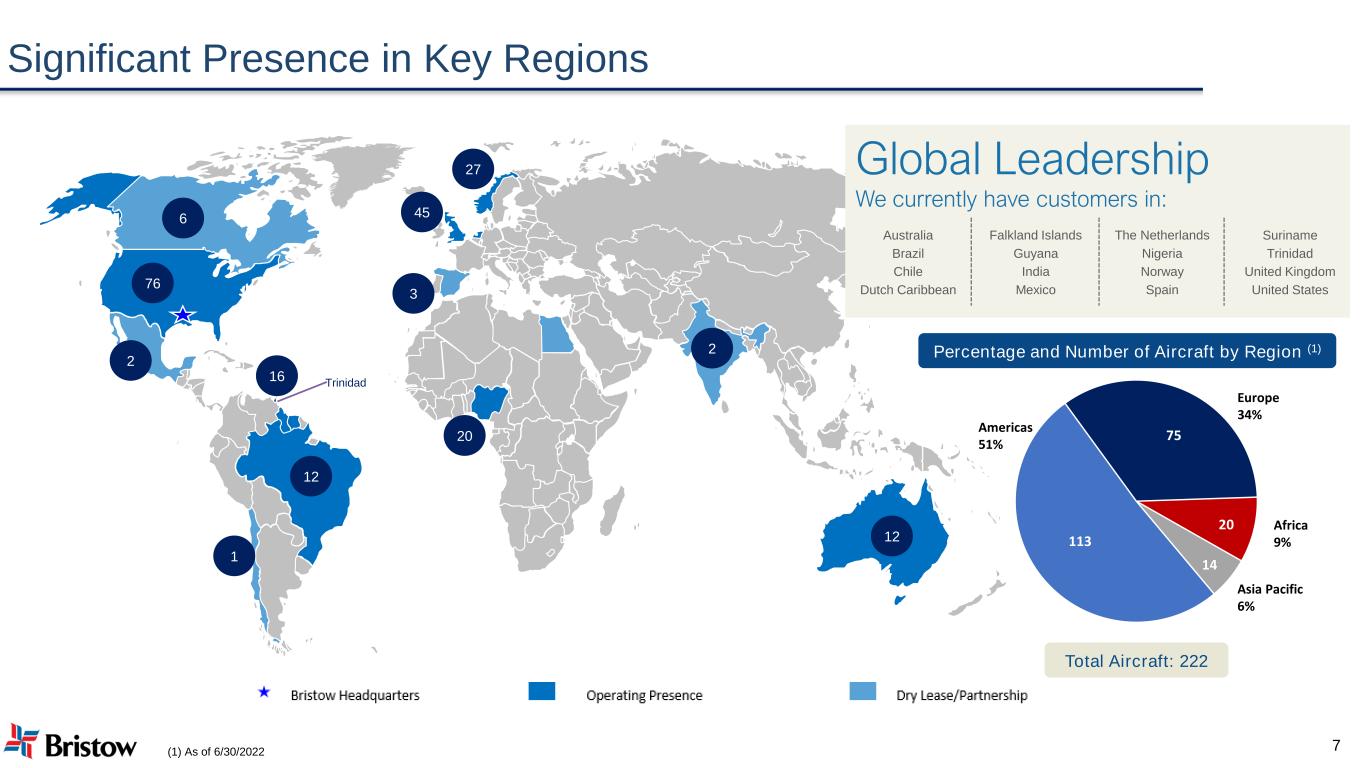
Significant Presence in Key Regions 7(1) As of 6/30/2022 Trinidad 12 2 20 3 27 6 76 12 2 16 45 1 Percentage and Number of Aircraft by Region (1) Total Aircraft: 222 Global Leadership We currently have customers in: Australia Brazil Chile Dutch Caribbean Falkland Islands Guyana India Mexico The Netherlands Nigeria Norway Spain Suriname Trinidad United Kingdom United States 113 75 20 14 Africa 9% Asia Pacific 6% Europe 34% Americas 51%
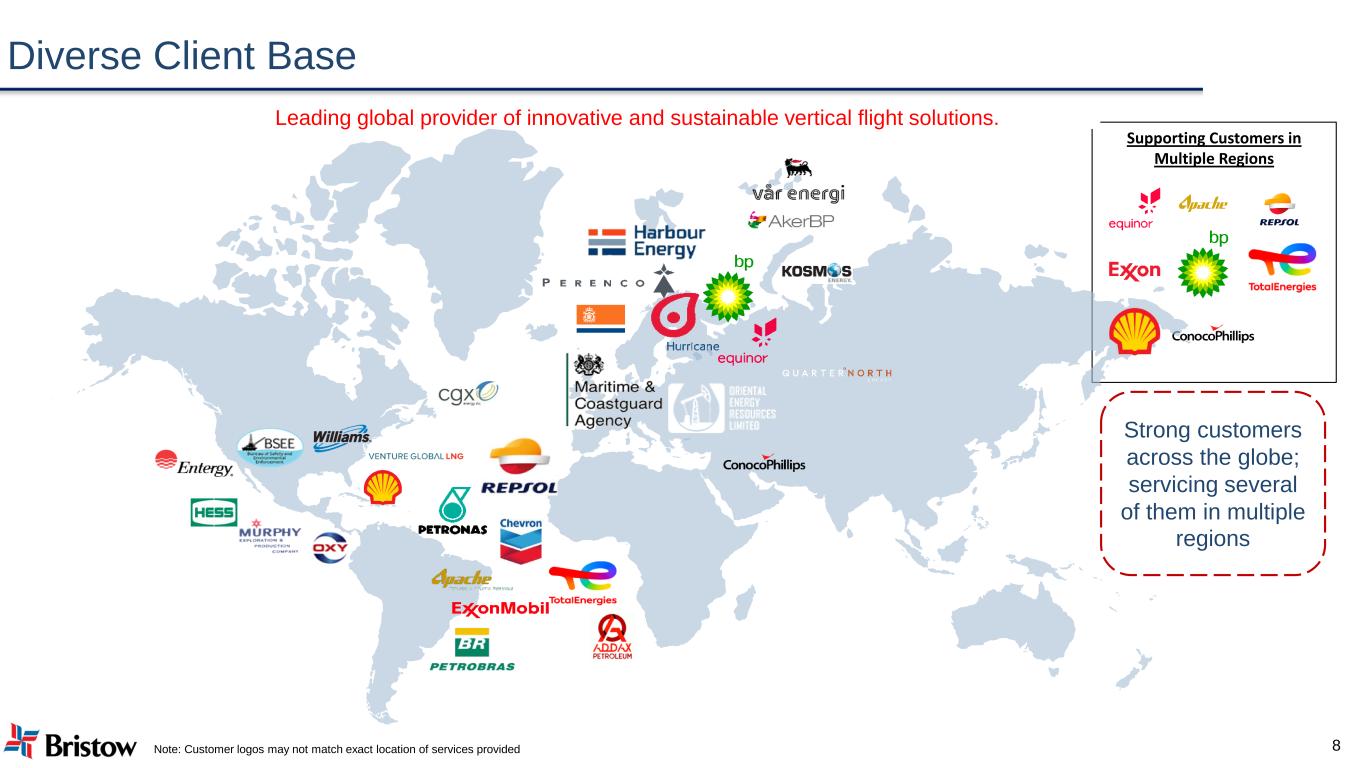
Supporting Customers in Multiple Regions Leading global provider of innovative and sustainable vertical flight solutions. Diverse Client Base 8Note: Customer logos may not match exact location of services provided Strong customers across the globe; servicing several of them in multiple regions
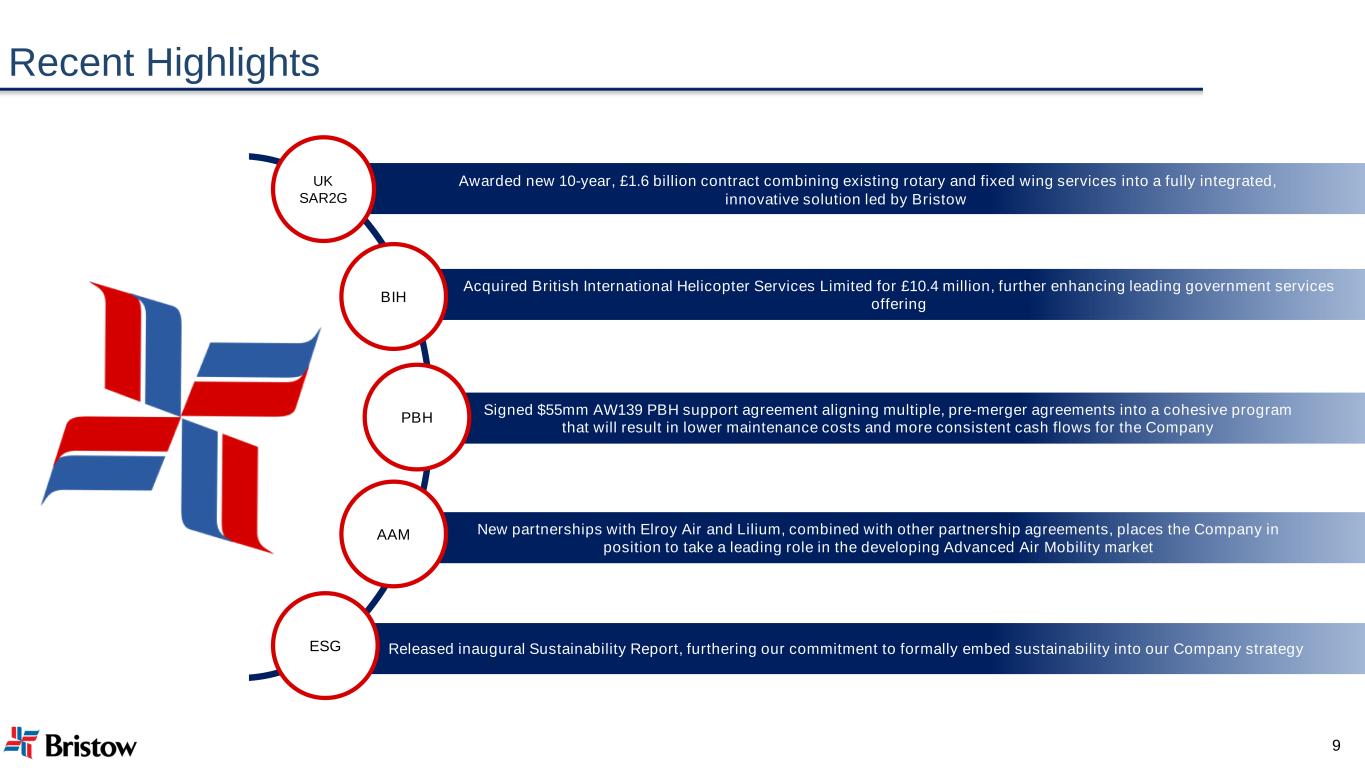
Recent Highlights 9 Awarded new 10-year, £1.6 billion contract combining existing rotary and fixed wing services into a fully integrated, innovative solution led by Bristow UK SAR2G Acquired British International Helicopter Services Limited for £10.4 million, further enhancing leading government services offering Signed $55mm AW139 PBH support agreement aligning multiple, pre-merger agreements into a cohesive program that will result in lower maintenance costs and more consistent cash flows for the Company New partnerships with Elroy Air and Lilium, combined with other partnership agreements, places the Company in position to take a leading role in the developing Advanced Air Mobility market Released inaugural Sustainability Report, furthering our commitment to formally embed sustainability into our Company strategy BIH PBH AAM ESG
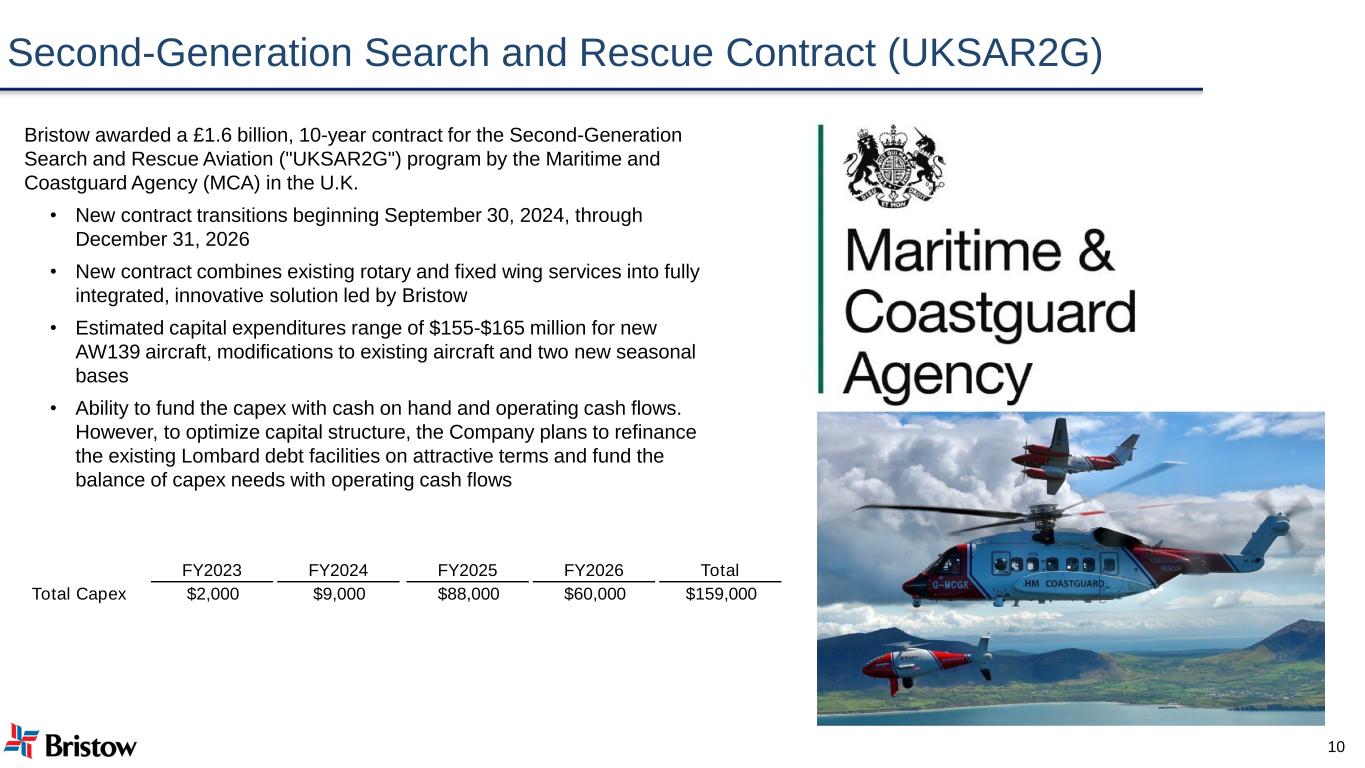
Second-Generation Search and Rescue Contract (UKSAR2G) Bristow awarded a £1.6 billion, 10-year contract for the Second-Generation Search and Rescue Aviation ("UKSAR2G") program by the Maritime and Coastguard Agency (MCA) in the U.K. • New contract transitions beginning September 30, 2024, through December 31, 2026 • New contract combines existing rotary and fixed wing services into fully integrated, innovative solution led by Bristow • Estimated capital expenditures range of $155-$165 million for new AW139 aircraft, modifications to existing aircraft and two new seasonal bases • Ability to fund the capex with cash on hand and operating cash flows. However, to optimize capital structure, the Company plans to refinance the existing Lombard debt facilities on attractive terms and fund the balance of capex needs with operating cash flows 10 FY2023 FY2024 FY2025 FY2026 Total Total Capex $2,000 $9,000 $88,000 $60,000 $159,000
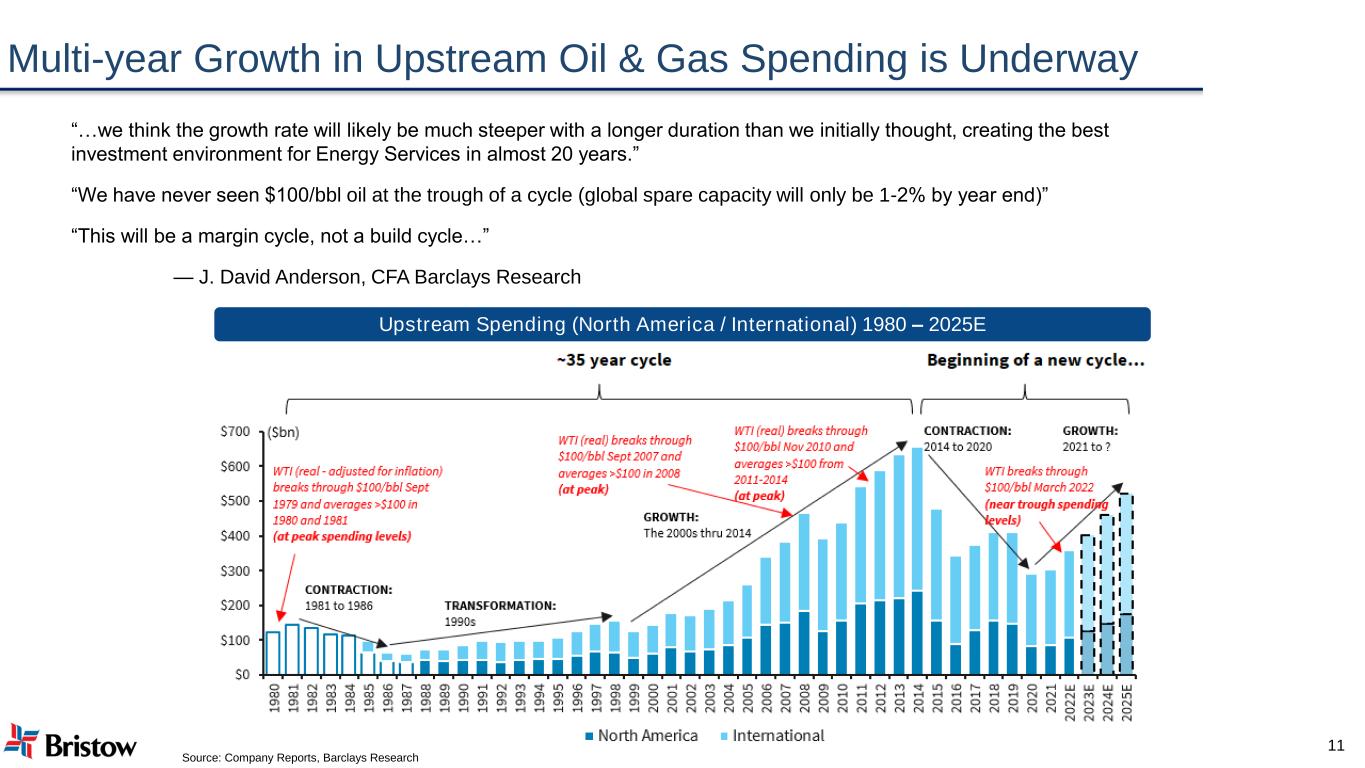
Multi-year Growth in Upstream Oil & Gas Spending is Underway “…we think the growth rate will likely be much steeper with a longer duration than we initially thought, creating the best investment environment for Energy Services in almost 20 years.” “We have never seen $100/bbl oil at the trough of a cycle (global spare capacity will only be 1-2% by year end)” “This will be a margin cycle, not a build cycle…” — J. David Anderson, CFA Barclays Research Source: Company Reports, Barclays Research 11 Upstream Spending (North America / International) 1980 – 2025E
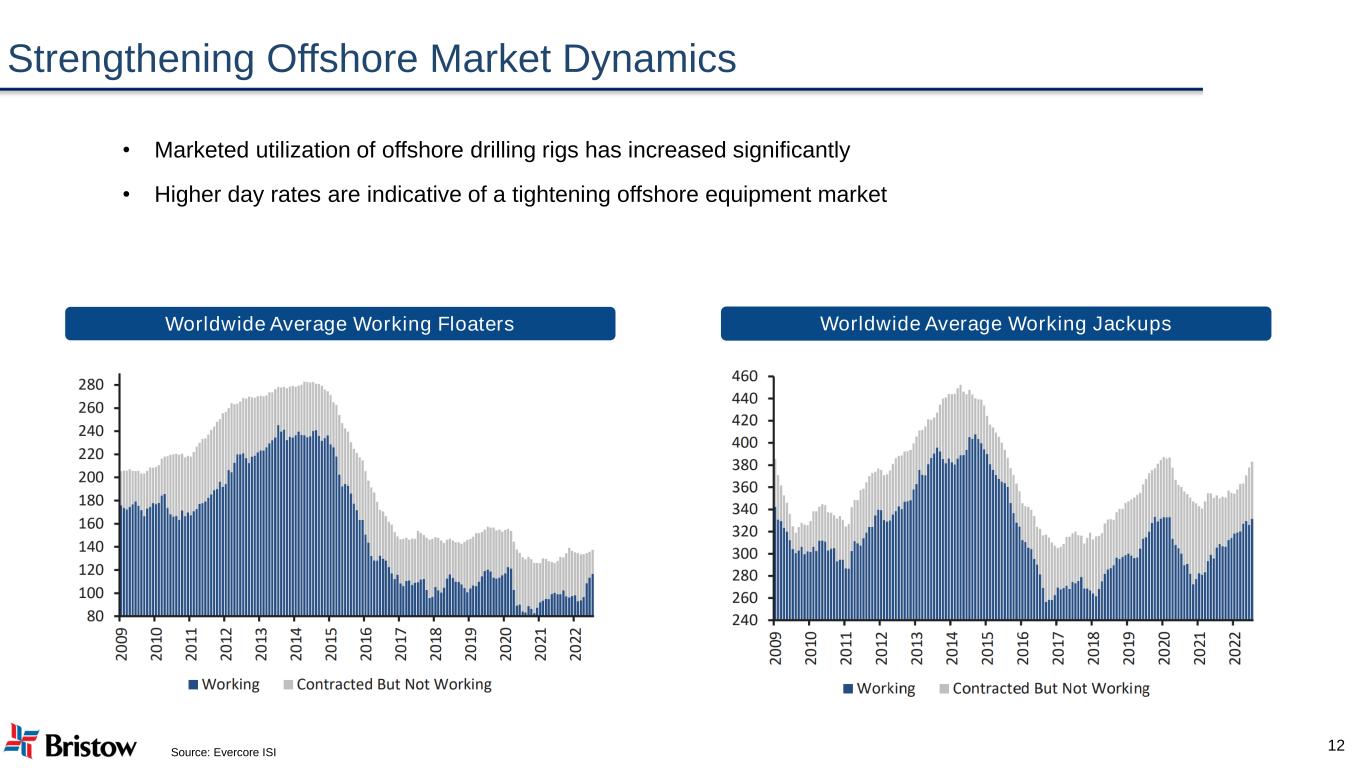
Strengthening Offshore Market Dynamics • Marketed utilization of offshore drilling rigs has increased significantly • Higher day rates are indicative of a tightening offshore equipment market Source: Evercore ISI 12 Worldwide Average Working Floaters Worldwide Average Working Jackups
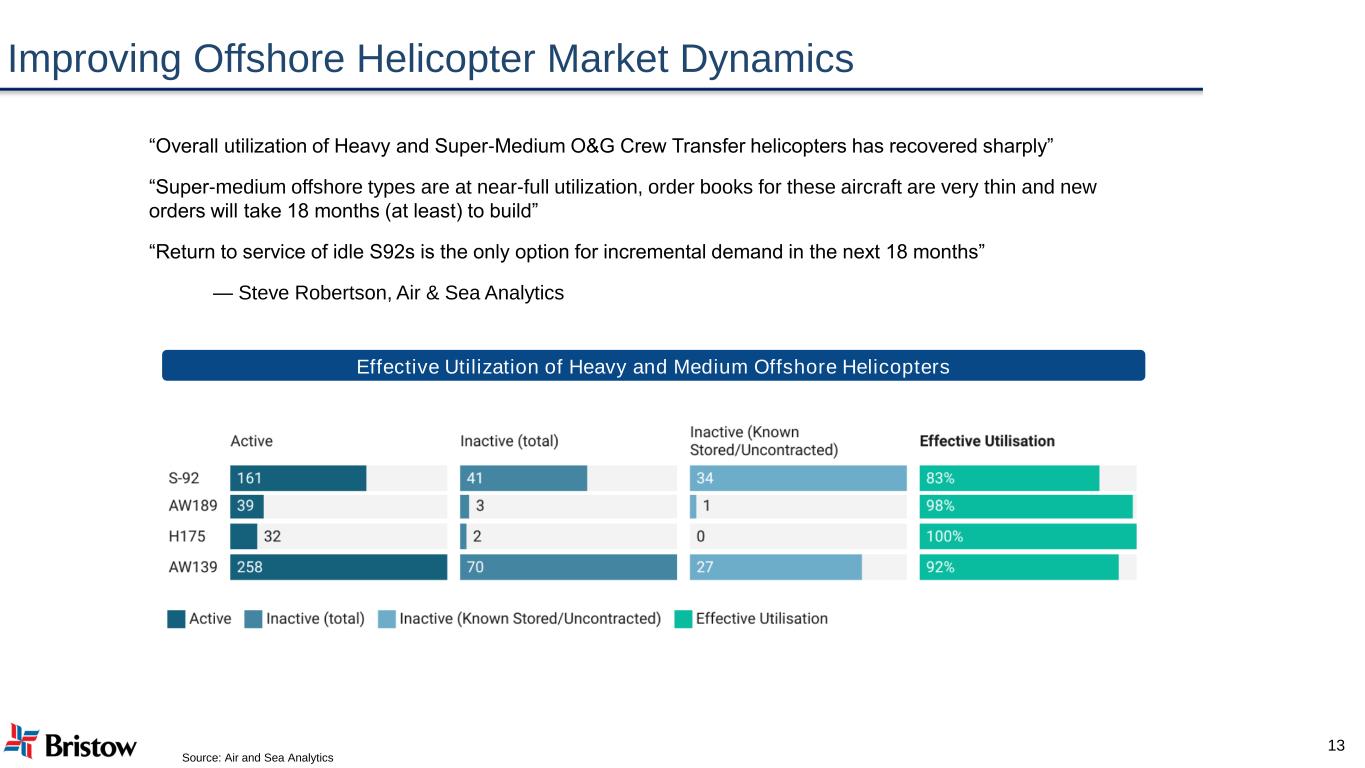
Improving Offshore Helicopter Market Dynamics “Overall utilization of Heavy and Super-Medium O&G Crew Transfer helicopters has recovered sharply” “Super-medium offshore types are at near-full utilization, order books for these aircraft are very thin and new orders will take 18 months (at least) to build” “Return to service of idle S92s is the only option for incremental demand in the next 18 months” — Steve Robertson, Air & Sea Analytics Source: Air and Sea Analytics 13 Effective Utilization of Heavy and Medium Offshore Helicopters
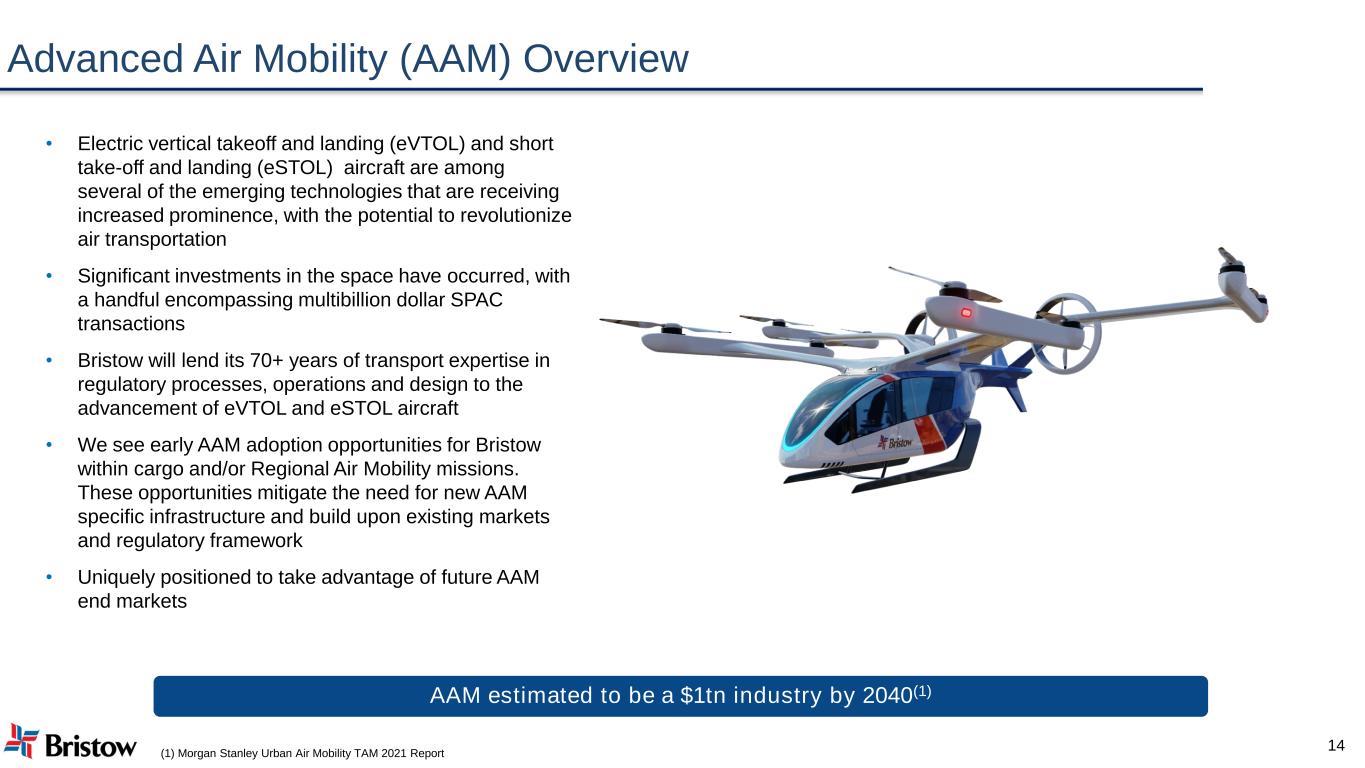
Advanced Air Mobility (AAM) Overview 14 • Electric vertical takeoff and landing (eVTOL) and short take-off and landing (eSTOL) aircraft are among several of the emerging technologies that are receiving increased prominence, with the potential to revolutionize air transportation • Significant investments in the space have occurred, with a handful encompassing multibillion dollar SPAC transactions • Bristow will lend its 70+ years of transport expertise in regulatory processes, operations and design to the advancement of eVTOL and eSTOL aircraft • We see early AAM adoption opportunities for Bristow within cargo and/or Regional Air Mobility missions. These opportunities mitigate the need for new AAM specific infrastructure and build upon existing markets and regulatory framework • Uniquely positioned to take advantage of future AAM end markets AAM estimated to be a $1tn industry by 2040(1) (1) Morgan Stanley Urban Air Mobility TAM 2021 Report
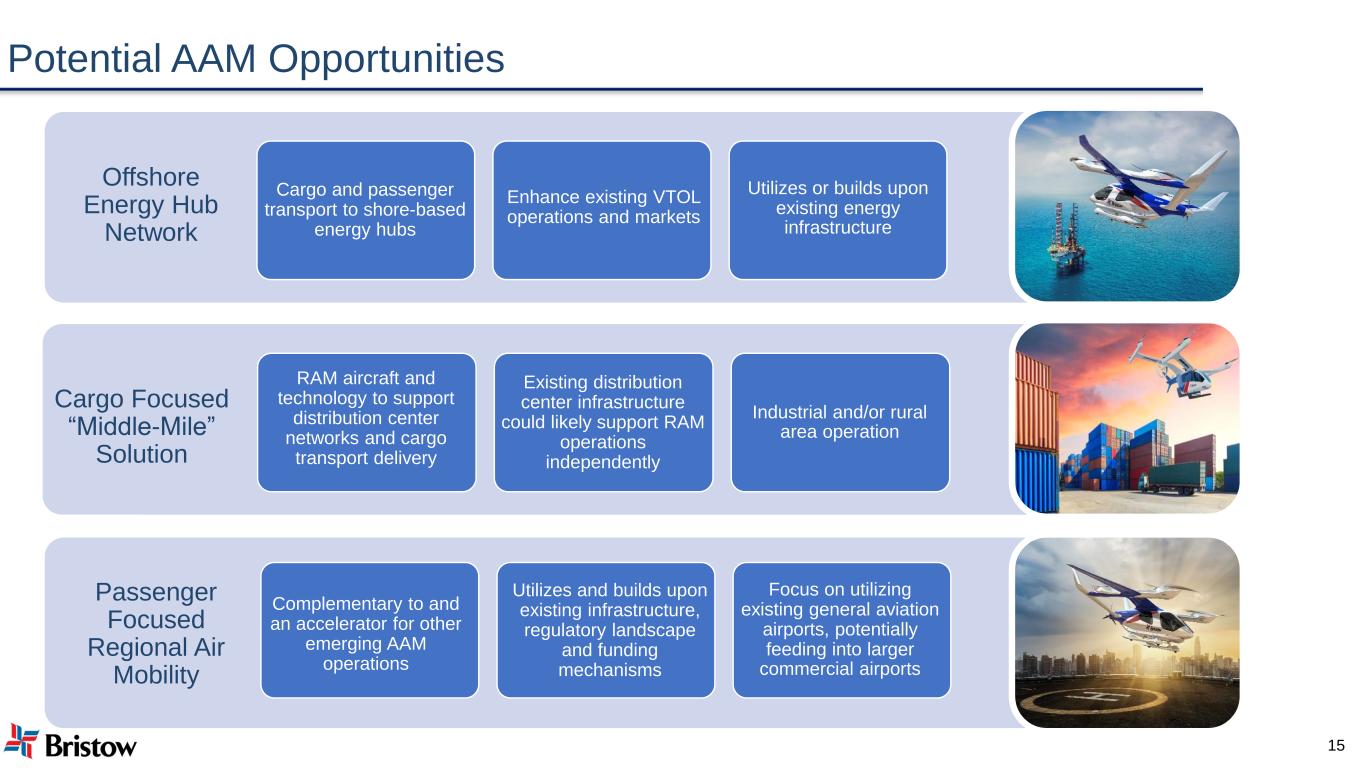
Potential AAM Opportunities Cargo Focused “Middle-Mile” Solution Passenger Focused Regional Air Mobility RAM aircraft and technology to support distribution center networks and cargo transport delivery Existing distribution center infrastructure could likely support RAM operations independently Industrial and/or rural area operation Offshore Energy Hub Network Cargo and passenger transport to shore-based energy hubs Enhance existing VTOL operations and markets Utilizes or builds upon existing energy infrastructure Complementary to and an accelerator for other emerging AAM operations Utilizes and builds upon existing infrastructure, regulatory landscape and funding mechanisms Focus on utilizing existing general aviation airports, potentially feeding into larger commercial airports 15
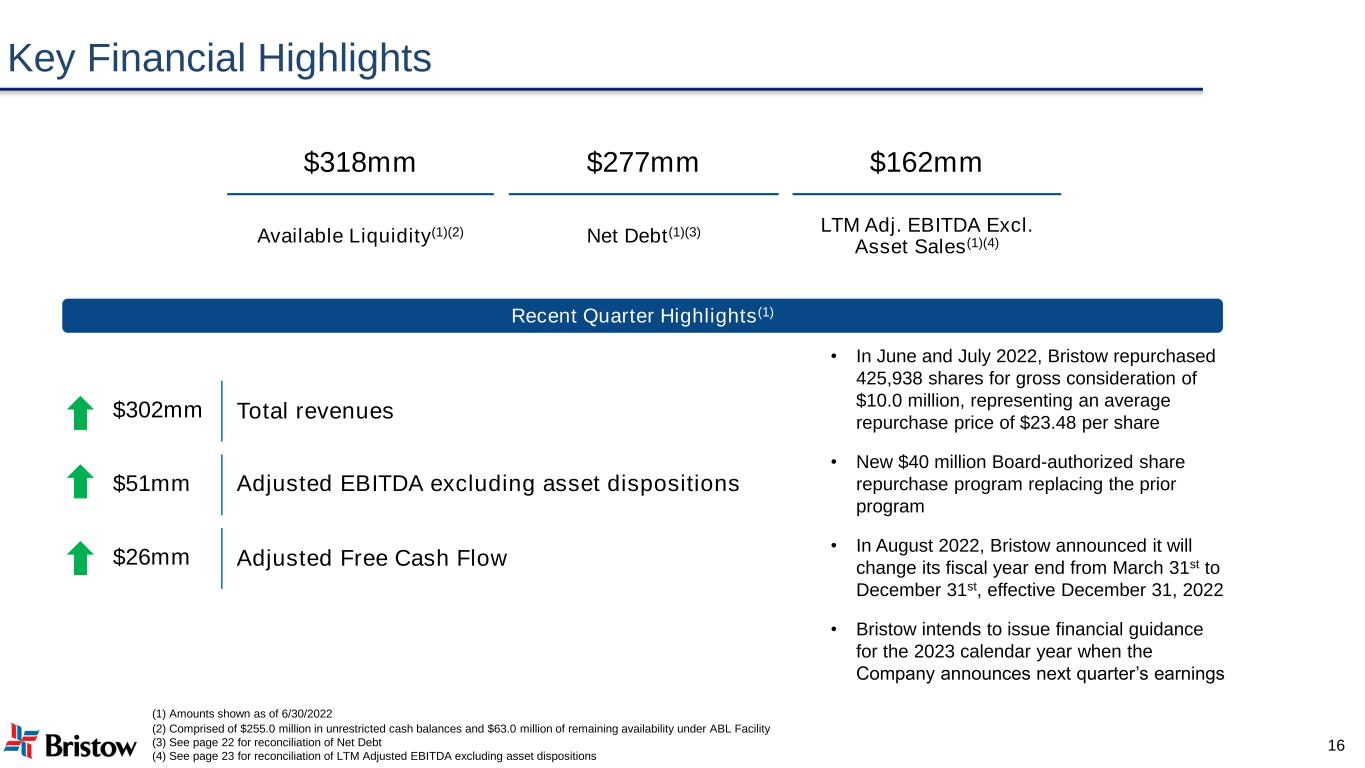
Key Financial Highlights (1) Amounts shown as of 6/30/2022 (2) Comprised of $255.0 million in unrestricted cash balances and $63.0 million of remaining availability under ABL Facility (3) See page 22 for reconciliation of Net Debt (4) See page 23 for reconciliation of LTM Adjusted EBITDA excluding asset dispositions 16 $318mm $277mm $162mm Available Liquidity(1)(2) Net Debt(1)(3) LTM Adj. EBITDA Excl. Asset Sales(1)(4) Recent Quarter Highlights(1) $302mm Total revenues $51mm Adjusted EBITDA excluding asset dispositions $26mm Adjusted Free Cash Flow • In June and July 2022, Bristow repurchased 425,938 shares for gross consideration of $10.0 million, representing an average repurchase price of $23.48 per share • New $40 million Board-authorized share repurchase program replacing the prior program • In August 2022, Bristow announced it will change its fiscal year end from March 31st to December 31st, effective December 31, 2022 • Bristow intends to issue financial guidance for the 2023 calendar year when the Company announces next quarter’s earnings
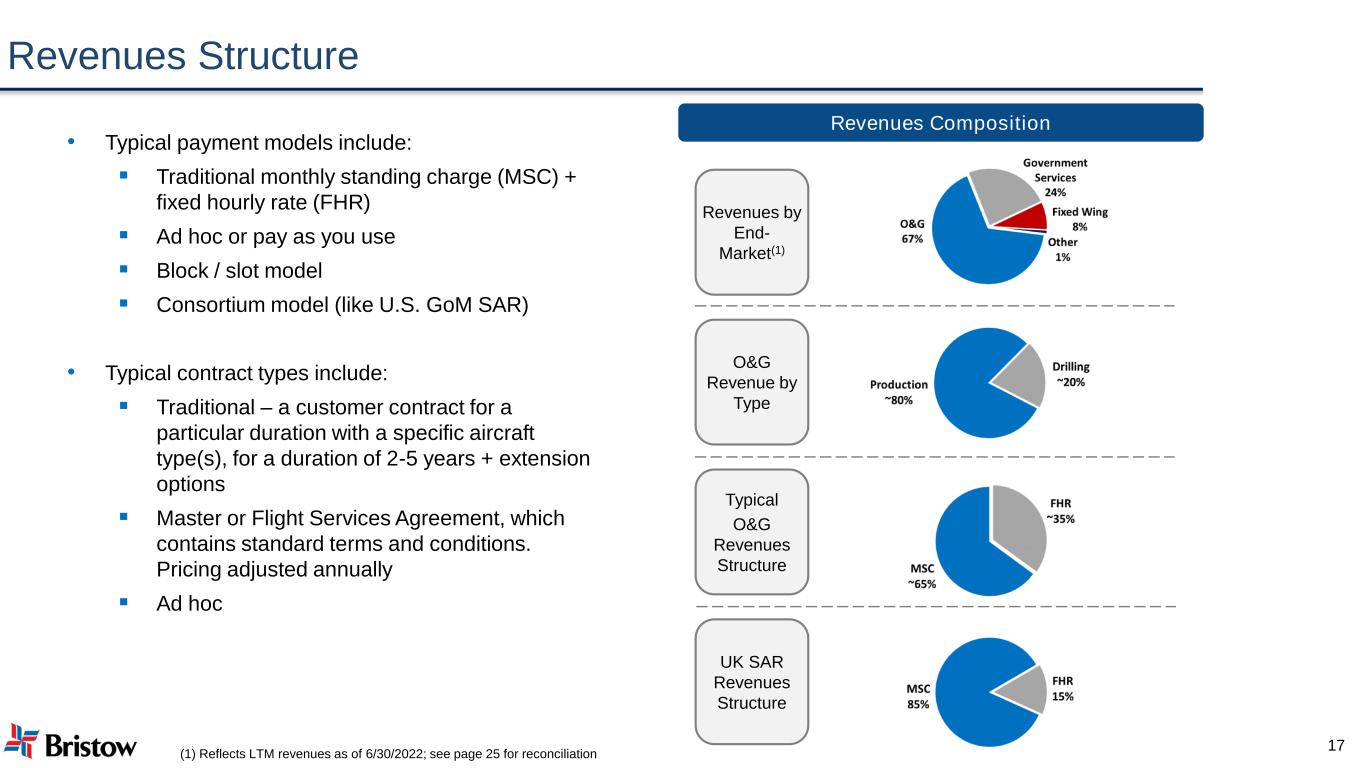
Revenues Structure 17 • Typical payment models include: ▪ Traditional monthly standing charge (MSC) + fixed hourly rate (FHR) ▪ Ad hoc or pay as you use ▪ Block / slot model ▪ Consortium model (like U.S. GoM SAR) • Typical contract types include: ▪ Traditional – a customer contract for a particular duration with a specific aircraft type(s), for a duration of 2-5 years + extension options ▪ Master or Flight Services Agreement, which contains standard terms and conditions. Pricing adjusted annually ▪ Ad hoc Revenues Composition Typical O&G Revenues Structure O&G Revenue by Type UK SAR Revenues Structure Revenues by End- Market(1) (1) Reflects LTM revenues as of 6/30/2022; see page 25 for reconciliation
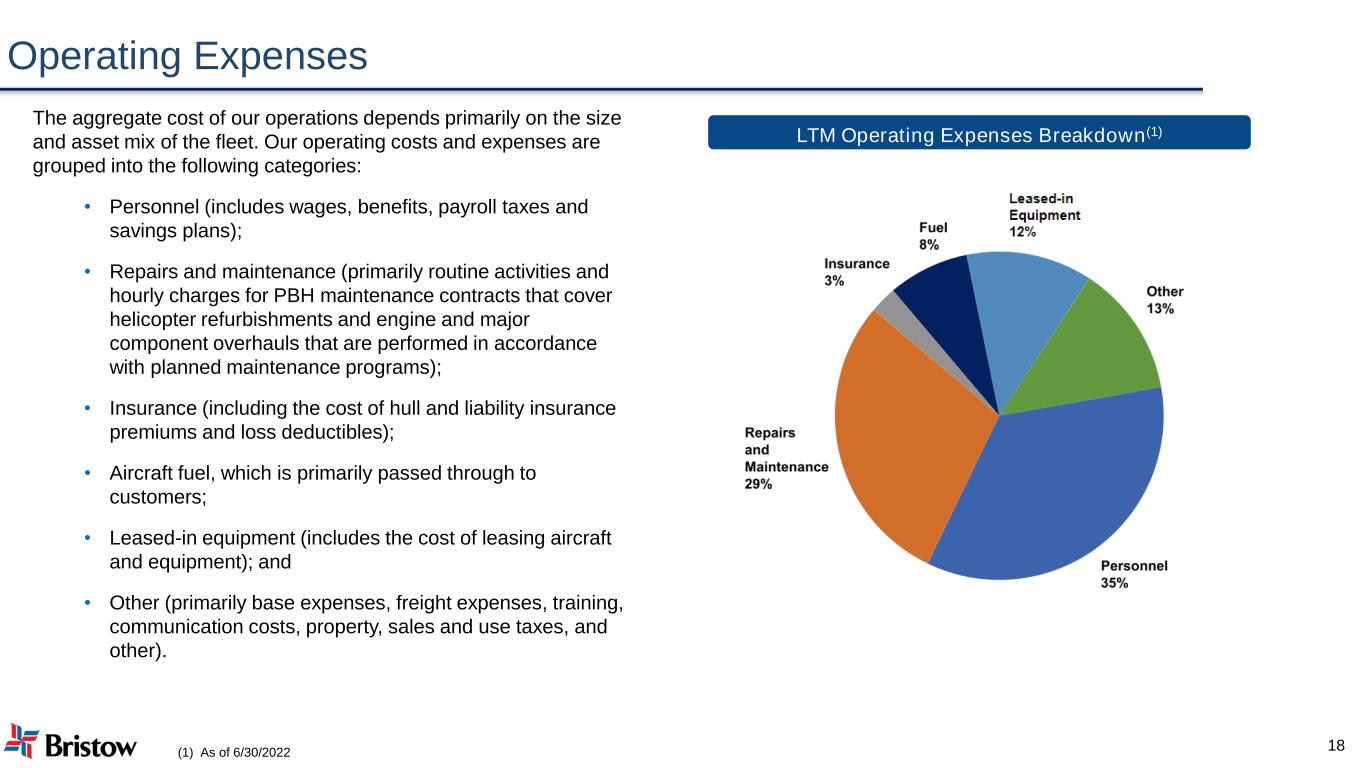
Operating Expenses 18 The aggregate cost of our operations depends primarily on the size and asset mix of the fleet. Our operating costs and expenses are grouped into the following categories: • Personnel (includes wages, benefits, payroll taxes and savings plans); • Repairs and maintenance (primarily routine activities and hourly charges for PBH maintenance contracts that cover helicopter refurbishments and engine and major component overhauls that are performed in accordance with planned maintenance programs); • Insurance (including the cost of hull and liability insurance premiums and loss deductibles); • Aircraft fuel, which is primarily passed through to customers; • Leased-in equipment (includes the cost of leasing aircraft and equipment); and • Other (primarily base expenses, freight expenses, training, communication costs, property, sales and use taxes, and other). LTM Operating Expenses Breakdown(1) (1) As of 6/30/2022
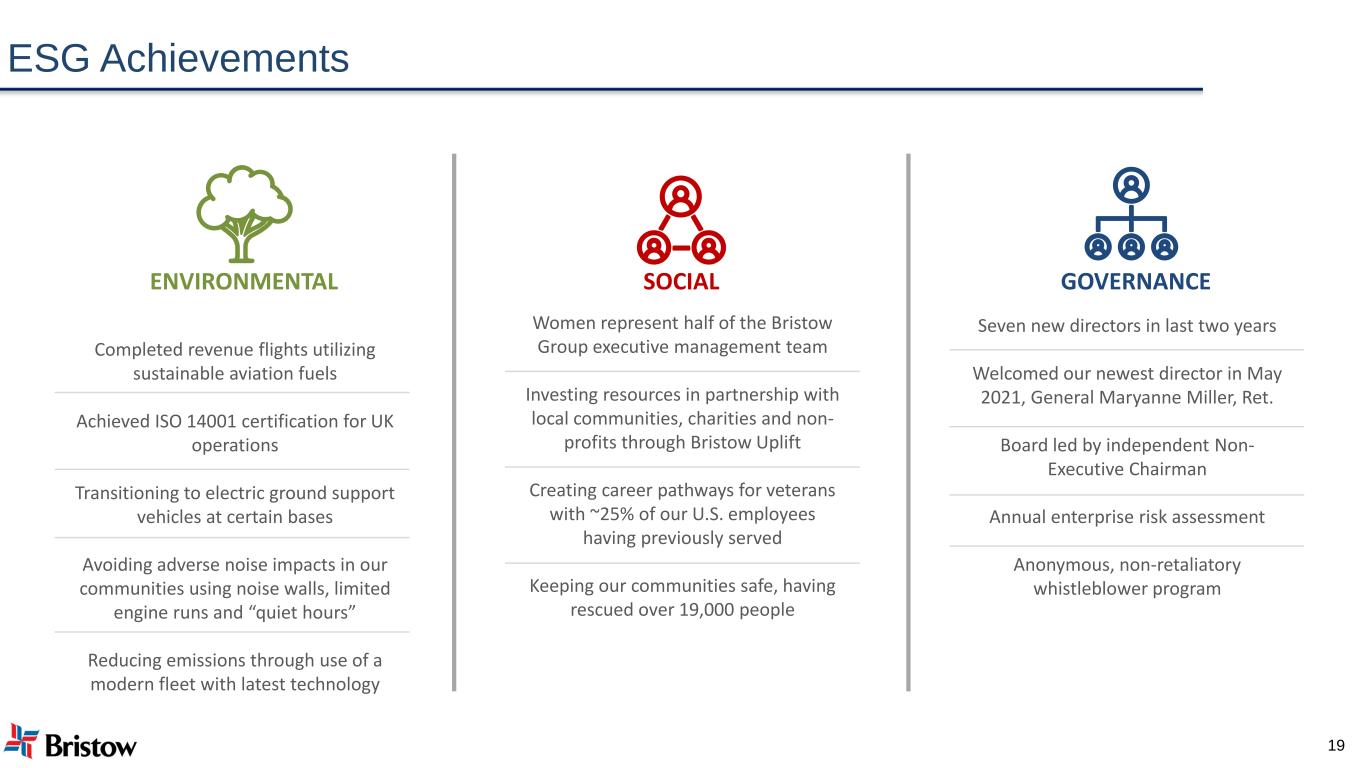
ESG Achievements 19 ENVIRONMENTAL SOCIAL GOVERNANCE Women represent half of the Bristow Group executive management team Investing resources in partnership with local communities, charities and non- profits through Bristow Uplift Creating career pathways for veterans with ~25% of our U.S. employees having previously served Keeping our communities safe, having rescued over 19,000 people Completed revenue flights utilizing sustainable aviation fuels Achieved ISO 14001 certification for UK operations Transitioning to electric ground support vehicles at certain bases Avoiding adverse noise impacts in our communities using noise walls, limited engine runs and “quiet hours” Reducing emissions through use of a modern fleet with latest technology Seven new directors in last two years Welcomed our newest director in May 2021, General Maryanne Miller, Ret. Board led by independent Non- Executive Chairman Annual enterprise risk assessment Anonymous, non-retaliatory whistleblower program
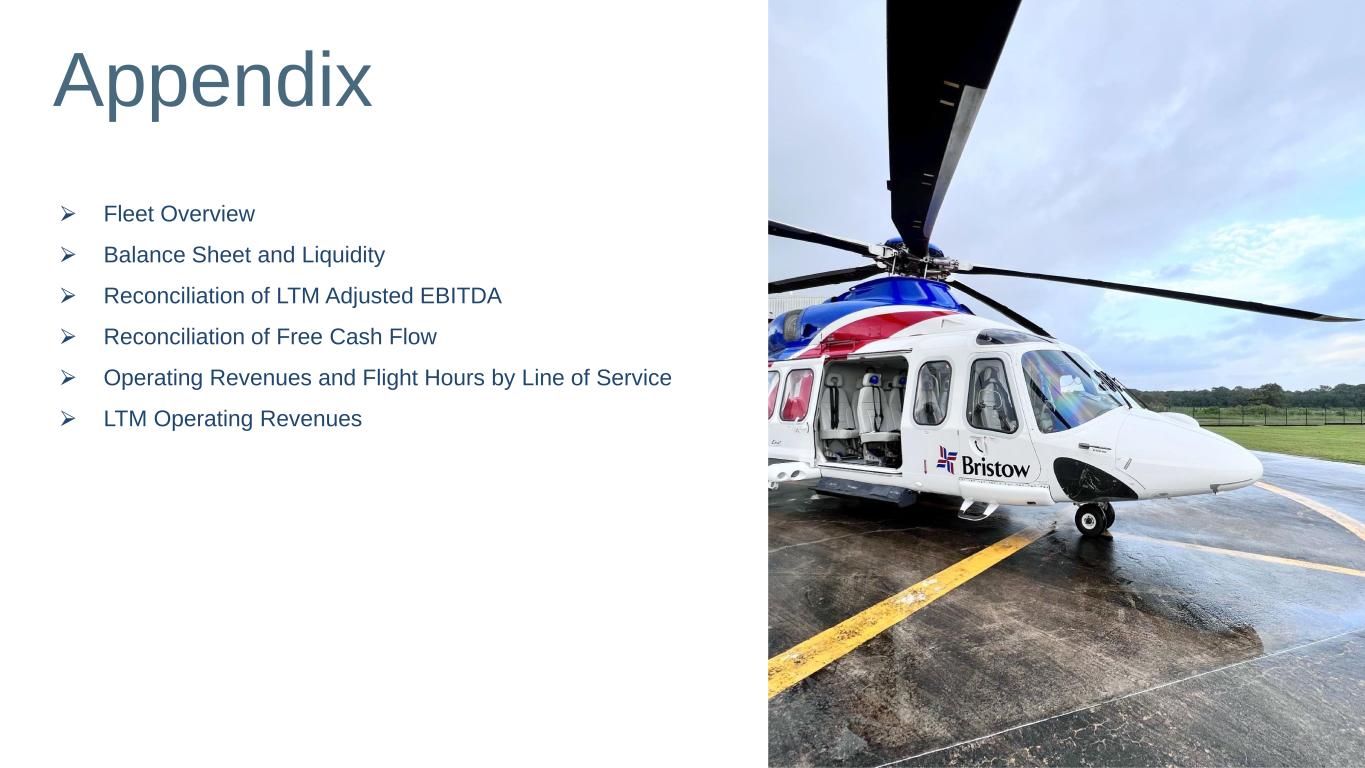
20 11 Appendix ⮚ Fleet Overview ⮚ Balance Sheet and Liquidity ⮚ Reconciliation of LTM Adjusted EBITDA ⮚ Reconciliation of Free Cash Flow ⮚ Operating Revenues and Flight Hours by Line of Service ⮚ LTM Operating Revenues
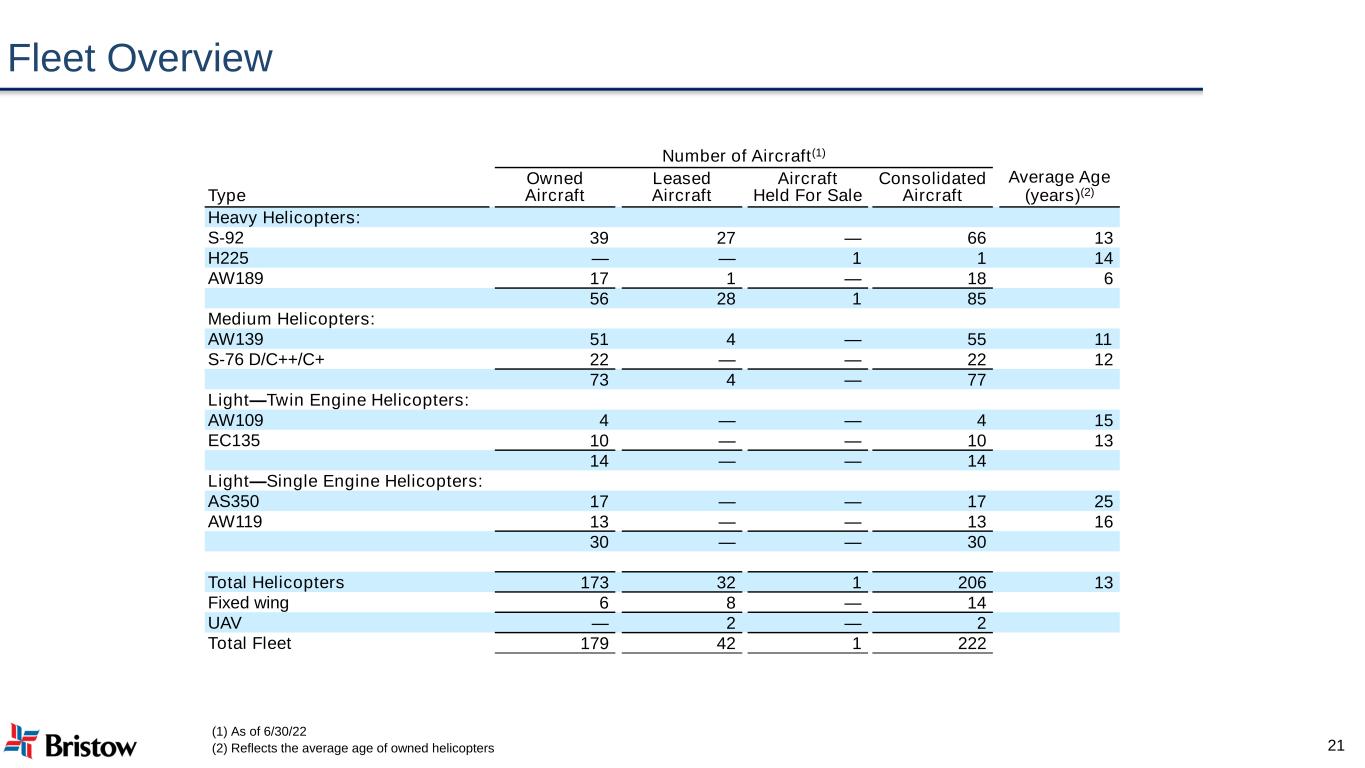
Fleet Overview (1) As of 6/30/22 (2) Reflects the average age of owned helicopters 21 Number of Aircraft(1) Type Owned Aircraft Leased Aircraft Aircraft Held For Sale Consolidated Aircraft Average Age (years)(2) Heavy Helicopters: S-92 39 27 — 66 13 H225 — — 1 1 14 AW189 17 1 — 18 6 56 28 1 85 Medium Helicopters: AW139 51 4 — 55 11 S-76 D/C++/C+ 22 — — 22 12 73 4 — 77 Light—Twin Engine Helicopters: AW109 4 — — 4 15 EC135 10 — — 10 13 14 — — 14 Light—Single Engine Helicopters: AS350 17 — — 17 25 AW119 13 — — 13 16 30 — — 30 Total Helicopters 173 32 1 206 13 Fixed wing 6 8 — 14 UAV — 2 — 2 Total Fleet 179 42 1 222
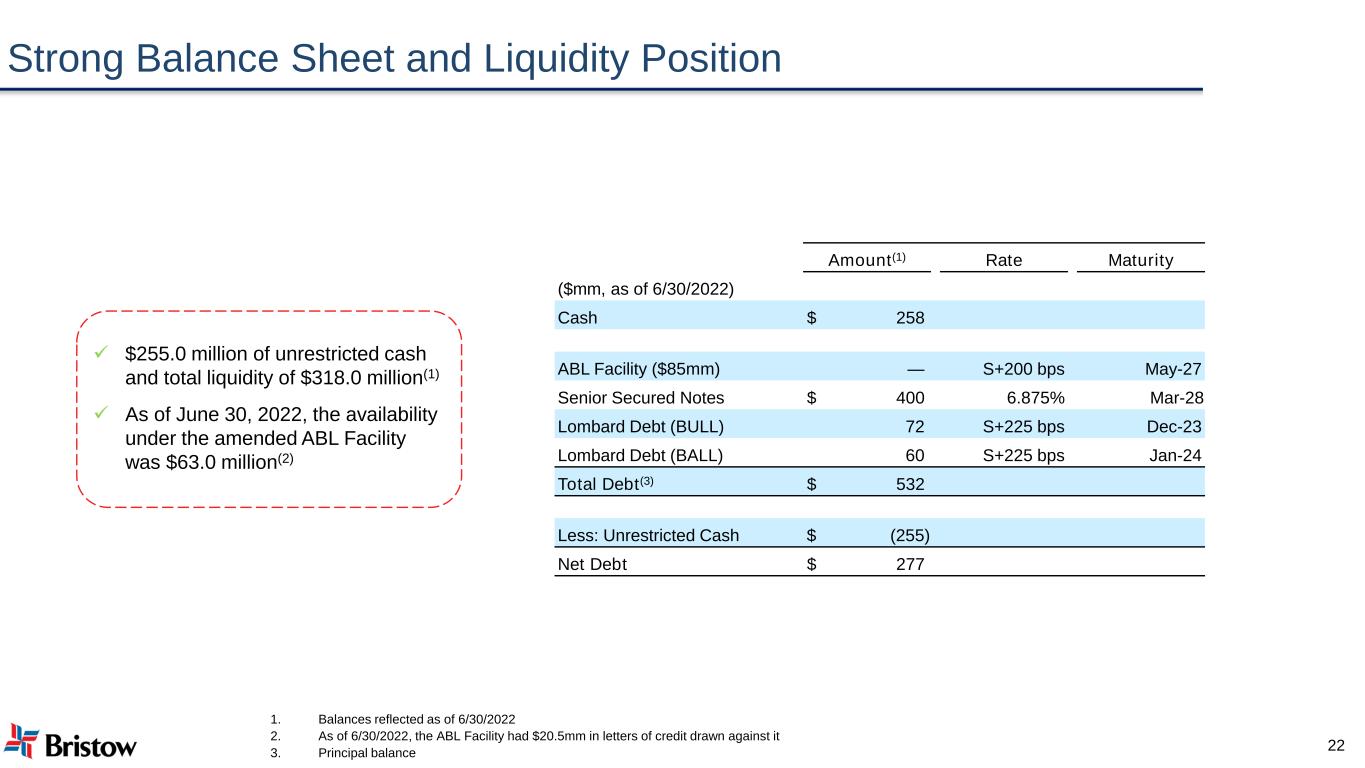
Strong Balance Sheet and Liquidity Position ✓ $255.0 million of unrestricted cash and total liquidity of $318.0 million(1) ✓ As of June 30, 2022, the availability under the amended ABL Facility was $63.0 million(2) 1. Balances reflected as of 6/30/2022 2. As of 6/30/2022, the ABL Facility had $20.5mm in letters of credit drawn against it 3. Principal balance Amount(1) Rate Maturity ($mm, as of 6/30/2022) Cash $ 258 ABL Facility ($85mm) — S+200 bps May-27 Senior Secured Notes $ 400 6.875% Mar-28 Lombard Debt (BULL) 72 S+225 bps Dec-23 Lombard Debt (BALL) 60 S+225 bps Jan-24 Total Debt(3) $ 532 Less: Unrestricted Cash $ (255) Net Debt $ 277 22
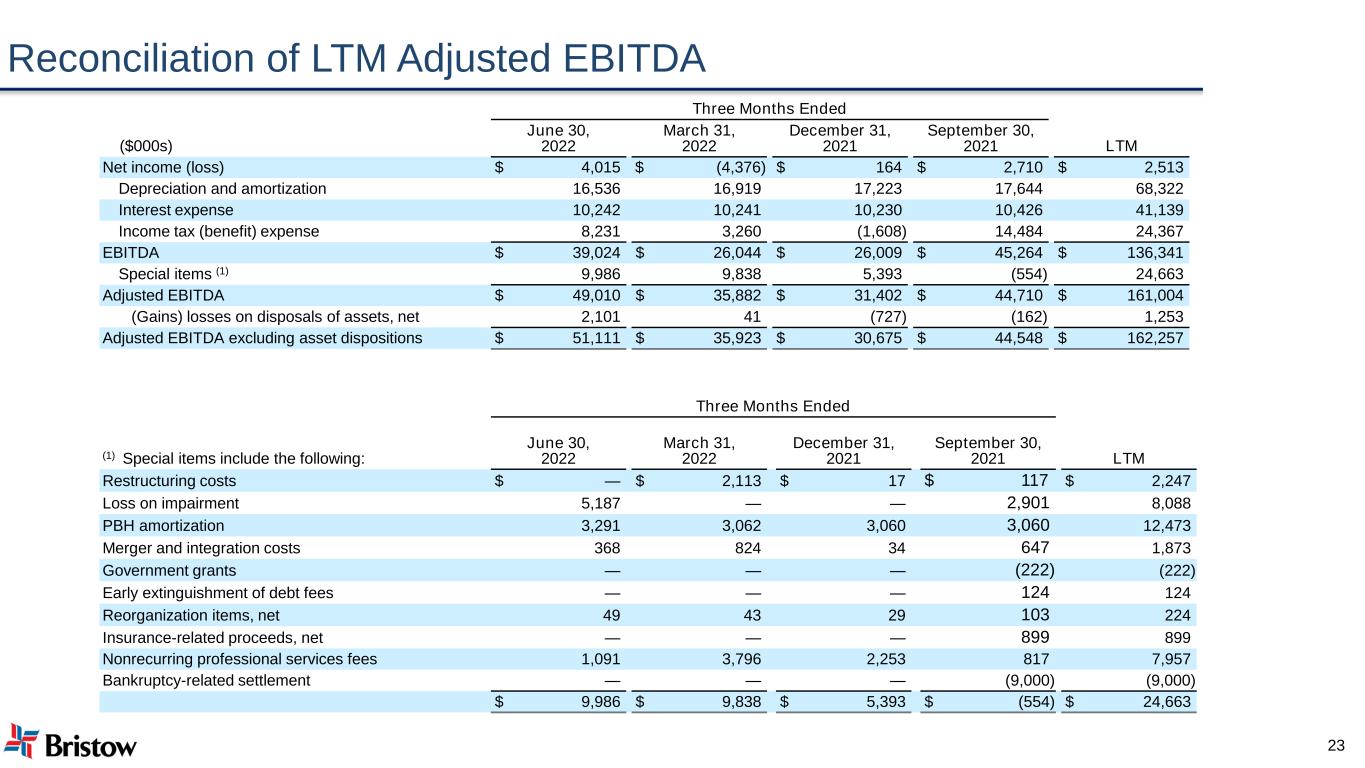
Reconciliation of LTM Adjusted EBITDA Three Months Ended ($000s) June 30, 2022 March 31, 2022 December 31, 2021 September 30, 2021 LTM Net income (loss) $ 4,015 $ (4,376) $ 164 $ 2,710 $ 2,513 Depreciation and amortization 16,536 16,919 17,223 17,644 68,322 Interest expense 10,242 10,241 10,230 10,426 41,139 Income tax (benefit) expense 8,231 3,260 (1,608) 14,484 24,367 EBITDA $ 39,024 $ 26,044 $ 26,009 $ 45,264 $ 136,341 Special items (1) 9,986 9,838 5,393 (554) 24,663 Adjusted EBITDA $ 49,010 $ 35,882 $ 31,402 $ 44,710 $ 161,004 (Gains) losses on disposals of assets, net 2,101 41 (727) (162) 1,253 Adjusted EBITDA excluding asset dispositions $ 51,111 $ 35,923 $ 30,675 $ 44,548 $ 162,257 23 Three Months Ended (1) Special items include the following: June 30, 2022 March 31, 2022 December 31, 2021 September 30, 2021 LTM Restructuring costs $ — $ 2,113 $ 17 $ 117 $ 2,247 Loss on impairment 5,187 — — 2,901 8,088 PBH amortization 3,291 3,062 3,060 3,060 12,473 Merger and integration costs 368 824 34 647 1,873 Government grants — — — (222) (222) Early extinguishment of debt fees — — — 124 124 Reorganization items, net 49 43 29 103 224 Insurance-related proceeds, net — — — 899 899 Nonrecurring professional services fees 1,091 3,796 2,253 817 7,957 Bankruptcy-related settlement — — — (9,000) (9,000) $ 9,986 $ 9,838 $ 5,393 $ (554) $ 24,663
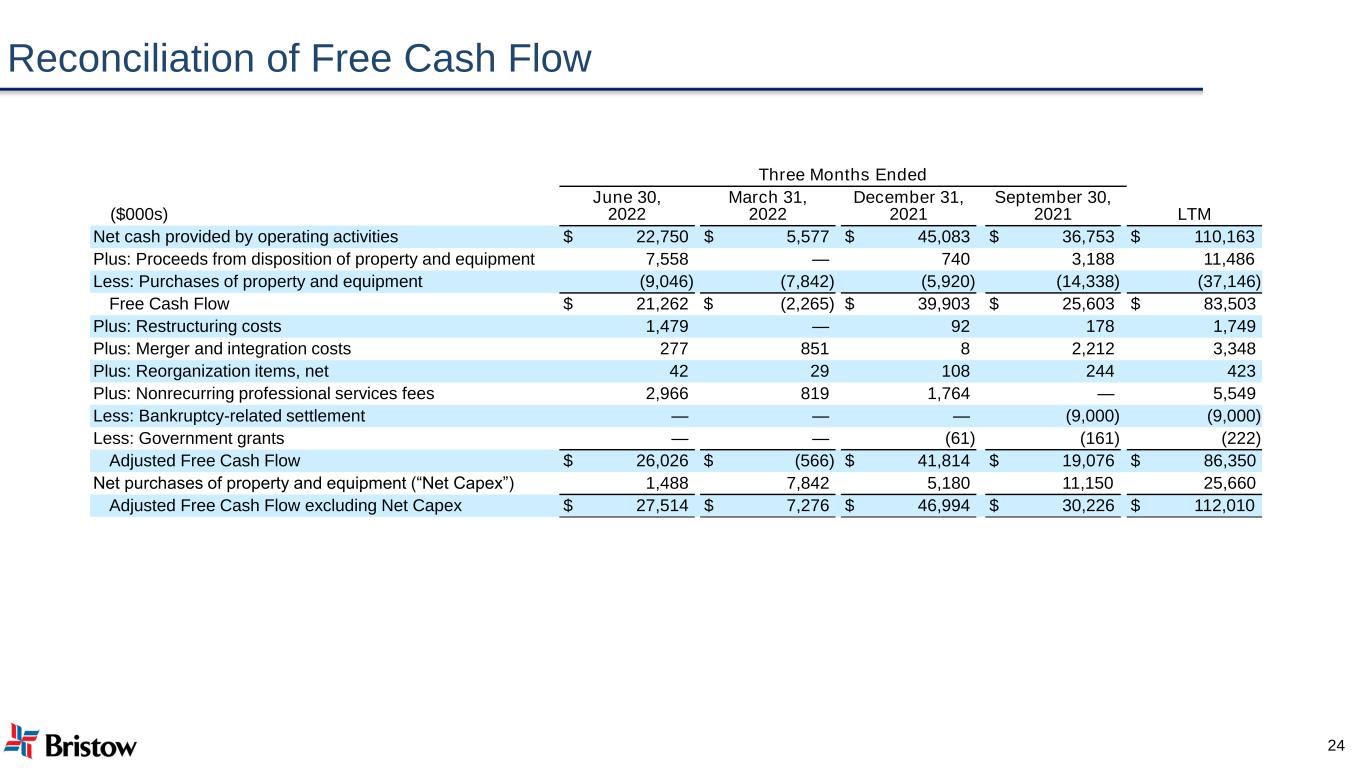
Reconciliation of Free Cash Flow 24 Three Months Ended ($000s) June 30, 2022 March 31, 2022 December 31, 2021 September 30, 2021 LTM Net cash provided by operating activities $ 22,750 $ 5,577 $ 45,083 $ 36,753 $ 110,163 Plus: Proceeds from disposition of property and equipment 7,558 — 740 3,188 11,486 Less: Purchases of property and equipment (9,046) (7,842) (5,920) (14,338) (37,146) Free Cash Flow $ 21,262 $ (2,265) $ 39,903 $ 25,603 $ 83,503 Plus: Restructuring costs 1,479 — 92 178 1,749 Plus: Merger and integration costs 277 851 8 2,212 3,348 Plus: Reorganization items, net 42 29 108 244 423 Plus: Nonrecurring professional services fees 2,966 819 1,764 — 5,549 Less: Bankruptcy-related settlement — — — (9,000) (9,000) Less: Government grants — — (61) (161) (222) Adjusted Free Cash Flow $ 26,026 $ (566) $ 41,814 $ 19,076 $ 86,350 Net purchases of property and equipment (“Net Capex”) 1,488 7,842 5,180 11,150 25,660 Adjusted Free Cash Flow excluding Net Capex $ 27,514 $ 7,276 $ 46,994 $ 30,226 $ 112,010
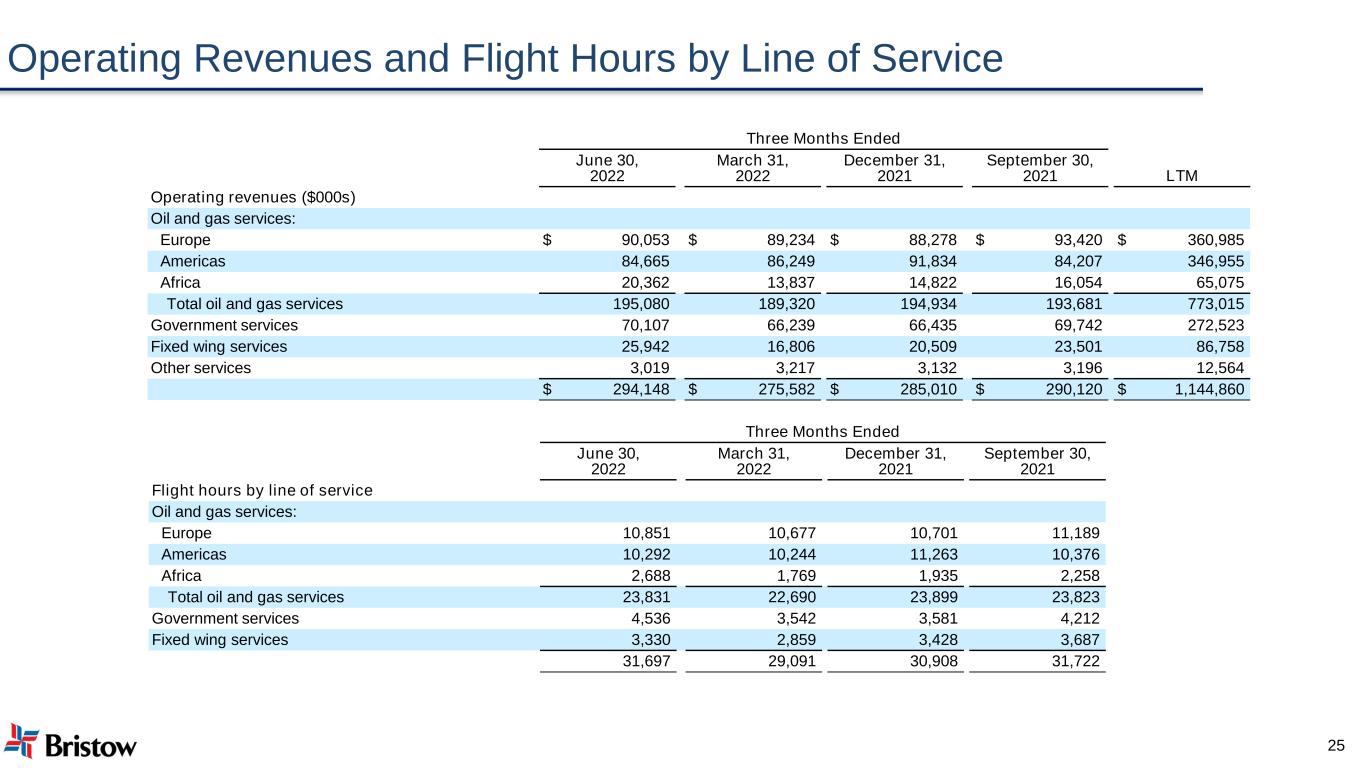
Operating Revenues and Flight Hours by Line of Service 25 Three Months Ended June 30, 2022 March 31, 2022 December 31, 2021 September 30, 2021 LTM Operating revenues ($000s) Oil and gas services: Europe $ 90,053 $ 89,234 $ 88,278 $ 93,420 $ 360,985 Americas 84,665 86,249 91,834 84,207 346,955 Africa 20,362 13,837 14,822 16,054 65,075 Total oil and gas services 195,080 189,320 194,934 193,681 773,015 Government services 70,107 66,239 66,435 69,742 272,523 Fixed wing services 25,942 16,806 20,509 23,501 86,758 Other services 3,019 3,217 3,132 3,196 12,564 $ 294,148 $ 275,582 $ 285,010 $ 290,120 $ 1,144,860 Three Months Ended June 30, 2022 March 31, 2022 December 31, 2021 September 30, 2021 Flight hours by line of service Oil and gas services: Europe 10,851 10,677 10,701 11,189 Americas 10,292 10,244 11,263 10,376 Africa 2,688 1,769 1,935 2,258 Total oil and gas services 23,831 22,690 23,899 23,823 Government services 4,536 3,542 3,581 4,212 Fixed wing services 3,330 2,859 3,428 3,687 31,697 29,091 30,908 31,722
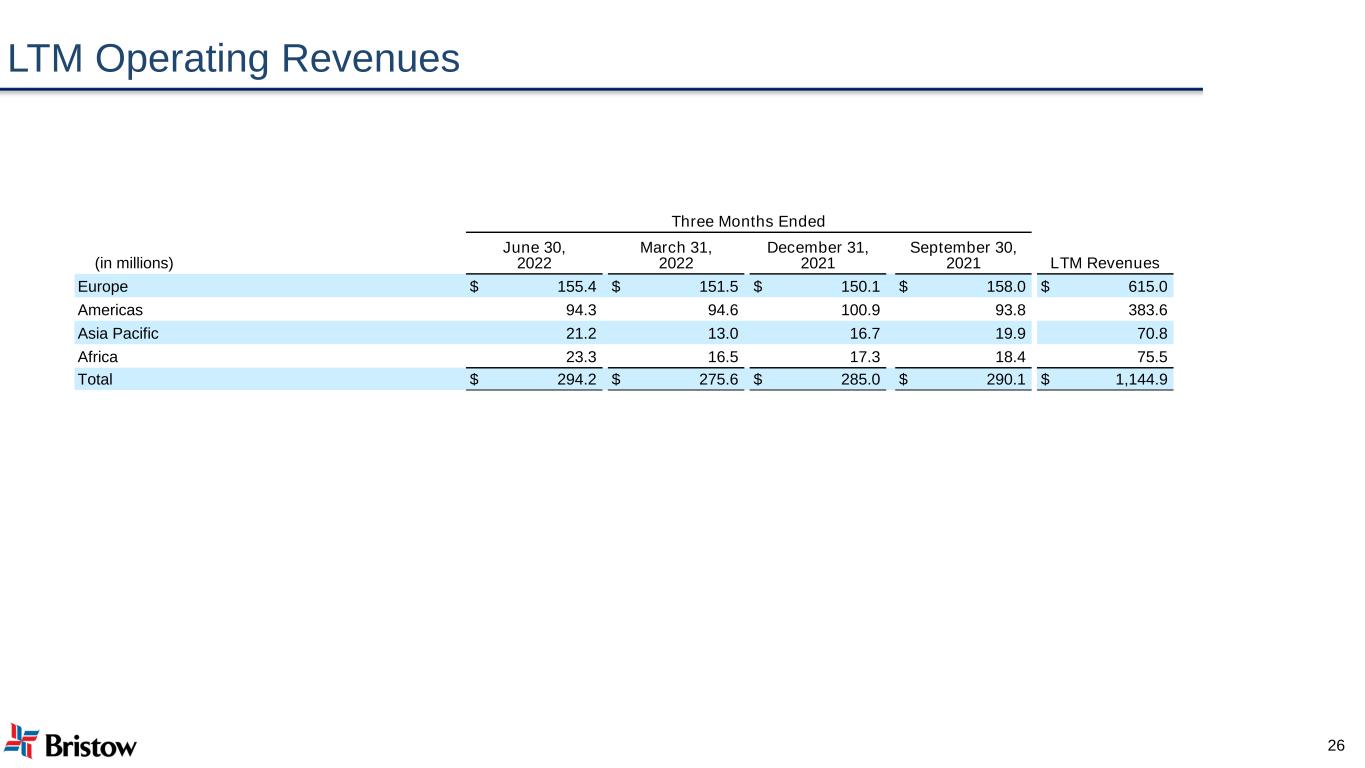
LTM Operating Revenues 26 Three Months Ended (in millions) June 30, 2022 March 31, 2022 December 31, 2021 September 30, 2021 LTM Revenues Europe $ 155.4 $ 151.5 $ 150.1 $ 158.0 $ 615.0 Americas 94.3 94.6 100.9 93.8 383.6 Asia Pacific 21.2 13.0 16.7 19.9 70.8 Africa 23.3 16.5 17.3 18.4 75.5 Total $ 294.2 $ 275.6 $ 285.0 $ 290.1 $ 1,144.9